

(FULL STORY ON PAGE 6)


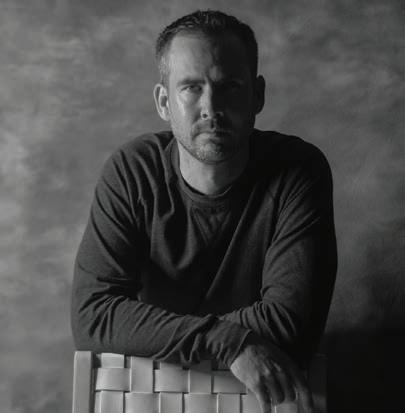
NEWS/FEATURE
02. Teaching With Style
Story by Olivia Cruz, Editor-in-Training
04. High on Energy, High on Risk
Story by Saraswathi Murugan, Editor-in-Training
05. The Weight of Words
Story by Saraswathi Murugan, Editor-in-Training
06. Senior Assasin
Story by Aurdrey Tzeng, Staff Reporter
8. Misused and Abused
Story by Jason Cardinini, Editor-in-Training
10. Competitive Calculus
Story by Radian Hong, Editor-in-Chief
12. Oops! I Did It Again
Story by Milana Kozlova Editor-in-Chief
14. The Underdogs
Story by Jason Cardinini, Editor-in-Training
16. All in the Details Story by Radian Hong, Editor-in-Chief
18. The Rap Effect Story by Bailee Sexton, Editor-in-Training
20. Decoding the Classroom Dilemma
Story by Lexi Booras, Staff Reporter
22. What Does Your Faith Mean to You?
Story by Saraswathi Murugan, Editor-in-Training
CONTENTS TABLE OF
(FULL STORY ON PAGE 10) (FULL STORY ON PAGE 22)



History Through Film: Is It Worth It? Story by Taylor Humbert, Staff Reporter
29. The Invisible Threat to Human Health
Story by Jasleen Grewal, Staff Reporter
32. Normalization of AI Story by Jasleen Grewal and Sophia Love, Staff Reporters 34. Tortured Poets
Story by Kaelyn Cunningham, Editor-in-Training
36. Go Touch Some Grass Story by Brynn Eckhardt Staff Reporter
40. The End of an Era Story by Sahil Ahmadi, Staff Reporter 41. Surviving Sports Story by Trey Joyce, Staff Reporter
42. New Additions
Story by Oliva Cruz, Editor-in-Training
30. A Pigment of Your Imagination
Story by Sophia Love, Staff Reporter
38. Rocklin’s Home Grown Hero
Story by Brady Kretzmer, Staff Reporter
44. The Road to Glory Story by Cole Broumas, Editor-in-Training
CONTENTS 01 THE FLASH 28.
OPINION/REVIEW
ON
(FULL STORY
PAGE 28)
(FULL STORY ON PAGE 30) (FULL STORY ON PAGE 44)
SPORTS
Teaching with

S TYLE All about teachers who have unique styles & how their fashion decisions affect the classroom.
Step foot into classrooms R-2, M-4, and R-11 to find teachers who are breaking the traditional expectations of how teachers should dress. These teachers are embracing their own personal style and bringing an extra dose of personality into the classroom. From eclectic, to comfortable, and even to skater styles, these educators are proving that self expression does not stop once you reach the classroom.
Shawn Hewson, Pilar Padilla, and Madison Nunos are some of the teachers here at Rocklin High School who have created a more exciting and inclusive learning environment for their students through their fashion decisions.
At Rocklin High School, teachers are normally seen wearing very neutral outfits consisting of jeans, simple shirts, and sneakers. But this stereotype does not bring happiness to all teachers. Long skirts, vests, bolo ties, and penny lane jackets make Mrs. Nunos, a special education teacher, feel most like herself. Unlike most teachers, Mrs. Nunos tries to “be fearless with [her] style, wear whatever [she] wants, and not focus on things that [she] has to wear to be considered professional.” Self-expression is most important to her, and she

shows her true self through the clothing that she wears. She describes her style as eclectic, which means that she brings a lot of different pieces that wouldn’t normally go together and she puts them together to create something different. Her interest in her personal style started in high school when she got inspiration from 50s and 60s fashion trends. This was when she first noticed that her style was unique compared to others. “I just kind of took with it and ran,” she said. “I started making my own clothes and it started to be something that made life fun.” From then to now, her style has never stopped evolving with the trends. Despite these changes, some things have stayed con-
stant for her, like the colors she wears. “A lot of the pieces have stayed the same, but I’ll add some different things depending on the style, or kind of the vibe I’m going for,” Mrs. Nunos said. “I dress this way because it truly makes me happy. I feel happier when I dress how I feel on the inside.”
“ “
I dress this way because it truly makes me happy, I feel happier when I dress how I feel on the inside.
Engineering support technology teacher
Mr. Hewson proposed the idea that the type of clothing teachers wear can have an effect on how students will act in the classroom. For example, Nunos dresses in a colorful and exciting way, so students might feel more excited to talk to her than a teacher who wears all black. As for Mr. Hewson, his day to day attire includes a big t-shirt, straight leg pants, and hightops. The most important part of his outfit is definitely a beanie. “It is such a part of my personality now that I don’t leave the house without something on my head,” he said. His outfits are heavily inspired by MTV and punk; in high school he was “definitely your stereotypical skat-

TYLE
er, and that has kind of stuck with [him] until today.” While some teachers are not able to dress how they would like, Mr. Hewson’s “position allows [him] to ex press [himself] in the way that [he] would normally do so on the street.” Mr. Hewson sees his fashion decisions as an important aspect of his teaching. He realizes that it is helpful to communicate with students and people in general. He feels like the way he dresses has allowed him to really connect with his students — “what’s good
“ what’s good about it, is that if nothing else, you guys know who I am, my students know who I am. “
All about teachers who have unique styles & how their
fashion
decisions affect the classroom.

about it is that, if nothing else, you guys know who I am, my students know who I am.” Mr. Hewson encourages teachers to dress how they wish, whether it’s professionally, laid back, or stylishly. Students will act depending on how their teacher presents themself, which is one of the reasons why Mr. Hewson dresses the way he does. Having his own style means that “the students recognize that Mr. teacher is actually a human being and not just a guy in a tie.”
I dress this way because it truly makes me happy, I feel happier when I dress how I feel on the inside.

Ms. Padilla, a former seamstress, takes on teaching while wearing her own unique style. The clothes that she finds most comfortable to teach in includes skorts, dresses, t-shirts, and hoodies. She says that, because she came from Santa Cruz, “her notion of appropriate is probably broader than most.” Her main goal when she picks out her outfits is comfort, so she is “always surprised if [she’s] wearing something [she] doesn’t like and people compliment her.” She just wears what she is most comfortable in, and without intention her students see her clothing choices as a sort of quirky and individual style.
By: Olivia Cruz, Staff Reporter

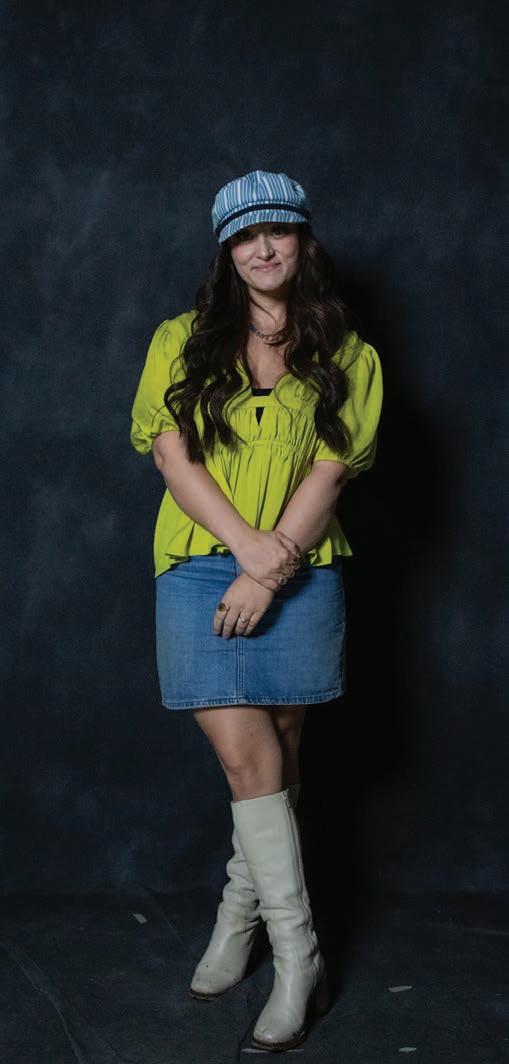

03 THE FLASH
H GH ON ENERGY H GH ON RISK
Energy drink addiction takes a toll on teenage health.
ENERGY DRINK CAFFEINE
Scattered like trophies of sleepless nights, empty energy drinks cans littered around high school campuses are a common sight. According to the National Center for Complementary and Integrative Health (NIH), nearly one-third of teens between 12 and 17 consume these stimulating beverages regularly. However, what begins as a temporary jolt of energy often reveals a deeper, more concerning trend: the romanticization of self-destructive behaviors to conform to social norms.
Cultural norms and societal expectations play a significant role in normalizing behaviors like staying late and relying on energy drinks.
In a society that glorifies the ‘hustle and grind’ culture, where success is often equated with extreme productivity and constant busyness, fueling oneself with energy drinks becomes a badge of honor. Monster, a popular energy drink brand, uses the slogan “Unleash the Beast,” promising consumers that the beverage will enable them to tap into their full productive potential.
Other times, the influence of media and pop culture on teenage trends can explain why students continue harmful behaviors de-
spite knowing their negative consequences. From movies and TV shows to social media influencers, teenagers are constantly exposed to images, trends, and lifestyles that can shape their perception of what is desirable or cool. For instance, Logan Paul leverages his popularity to sell his energy drink to his fanbase despite known safety concerns.
UCLA Health reports that many adolescents already face a caffeine dependence, partly due to colorful packaging, candy-like flavorings, and widespread availability. The Child-Mind Institute states that teenagers need 9.25 hours of sleep to be optimally alert. Yet, multiple studies have indicated that the vast majority today are living with borderline to severe sleep deprivation. The study claims that “Half the teens one expert evaluated were so tired in the morning they showed the same symptoms as patients with narcolepsy, a sleep disorder in which the patient nods off and falls directly into REM sleep.” As these habits become deeply ingrained, the line between choice and necessity blurs, making it challenging to break free from the cycle.
SLEEP
VATION RELIANCE ADDICTION ANXIETY MENTAL HEALTH SUGAR WORRY STRESS
DEPRI-
DRINK. STUDY. NO SLEEP. REPEAT. Anxiety Heart Risk Heart Failure diabetes
The Weight Of Words
Disclaimer: This article is intended for informational purposes only and should not be considered as medical advice. This article does not intend to dismiss or invalidate the experiences of those living with mental health disorders, but rather aims to explore the societal influences that may contribute to the normalization of harmful behaviors.
Walk into any class on campus, and soon enough, you will hear students casually say, “I’m so depressed” or “What if I just killed myself?” to cope with a bad essay grade or test score. In many cases, these terms are used casually and inaccurately to describe feelings of fatigue, stress, or temporary sadness rather than the clinical conditions they represent. This misuse of language can trivialize the experience of those living with depression or anxiety, diminishing the seriousness of these mental health disorders.
Language plays a crucial role in shaping our perceptions of mental health, particularly when it comes to perpetuating stigma. According to author Jane Roper, “When you’re really sad, you might not feel like getting out of bed. When you’re clinically depressed, you can’t”. Roper explains that the problem with people casually using the term “depressed” as a catch-all for unhappiness is that it perpetuates misunderstanding and stigma around major depression — which too many still view as a result of weakness, laziness, or a character flaw.
As students repeatedly use lan-
guage that romanticizes or trivializes mental health issues, their brains adapt to repeat these patterns of speech. As a result, their brains adapt to make these actions more automatic and less cognitively demanding, and they often self-diagnose or fully dismiss their symptoms.

Individuals must carefully consider their words when discussing sensitive topics, as habits can quickly become ingrained behaviors that are challenging to change. This is especially true when these habits are reinforced by societal norms or cultural expectations.
If you are in a crisis, call 988, the Suicide and Crisis Lifeline
What if I just...
 Stories by: Saraswathi Murugan, Editor-in-Training
Stories by: Saraswathi Murugan, Editor-in-Training
Design by: Kaelyn Cunningham,
Editor-in-Training
05 THE FLASH
SENIORS STRATEGY, STALKING, and TARGETED:
For a few weeks at the end of each year, the senior class can be seen walking around campus toting water guns, floaties, and goggles. This is all part of the fun in a traditional game known as Senior Assassin.
Senior Assassin is a game run by anonymous people who are not part of RHS ASB. Seniors can join by paying $5 as an entry fee. In each round of the game, every player is randomly assigned a “target.” Players can eliminate their targets by squirting them with a water gun, unless they happen to be wearing goggles and floaties. The only times these items do not protect players are on “Purge Days.” Players can also be eliminated by failing to get their own target out in a certain amount of time.
Additionally, players can only be eliminated at certain places. Players cannot be eliminated inside work, church, or on campus, but they can be eliminated while entering or exiting these places. Everywhere else, including the school parking lot, outside a target’s house, or even inside a target’s house if given permission by someone who lives there, is free game. Players may even enter their target’s car if it is unlocked.
Overall, the objective of the game is to stay alive as long as possible. Eventually, only one player will be left in the game and will win a large cash prize.
“I definitely checked my front yard this morning three times just to make sure he wasn’t standing in the bushes or anything…”
 - Kaitlin Dunn, Senior.
- Kaitlin Dunn, Senior.
After a player finds out their target’s name, the first step is to find out their identity and whereabouts. Senior Kaitlin Dunn, who is participating in the game this year, said, “Instagram is a big help if you don’t know who your person is. Some people have Snapchat, and their locations are on. So that’s been a big help for a lot of people too.”
In this digital age, it is even easy for people to find out addresses. Dunn said, “If you look up their parent’s name, then you can look them up on Google and [their address will] pop up automatically. It’s crazy how easy it is to find addresses.”
Of course, it is not what you know but who you know that also helps. Senior Taylor Luiz, another participant of the game this year, said, “I had a friend whose cousin was neighbors with [my target.] They were telling me that he leaves super early in the morning, so I just went outside of his house and hid
next to his garage for an hour in the morning until he left. I got him as he was walking out because he didn’t have goggles or floaties on.”
Waking up early in the hopes of ambushing a target when they leave their house is a common strategy for assassins. Dunn said, “I was in front of my target’s house from 5:30 to 8:30 a couple of weeks ago. [Then his friends] pulled up in front of his house and saw me and I know his friends because I’m neighbors with one of them.”
While Dunn may not have been able to get her target out, she is not the only one who had trouble eliminating their target. Her own assassin attempted to get her out as well. Dunn said, “He tried to get me a couple of days ago and then my mom accidentally gave it away. He was hiding in our front yard. I had my goggles on luckily, but he ran away really fast.”
One of the rules of Senior Assassin is that players must get a video of themselves assassinating their target. The

videos are posted on an Instagram page that runs the event, along with rules of the game and notices for Purge Days. This allows everyone to enjoy the videos of players assassinating their targets.
Luiz said, “I noticed one [girl’s] video on Instagram. She got permission from a resident to go into somebody’s house, and she was looking around for the person. But the person’s parent set them up so that the girl’s target got her out. If someone’s going after you, you can shoot [them] with a water gun and get them out as well, even if they’re not your target.”
Despite managing to eliminate a target, Luiz herself was eliminated before managing to get out her new target. Luiz said, “I lost my goggles yesterday and then I was out in the parking lot. My assassin came up and got me and I was not expecting it. I thought someone else was my assassin.”
Allies are also a big part of Senior Assassin. Senior Tori Gridley is participating in the game this year as well. Gridley said, “This past round was when I helped one of my friends get out her target. [Her target] had me. I baited him into thinking, ‘Oh, I can get Tori right now.’ But then it was actually her waiting for him. And so she got him out.”
Strategy is what makes Senior Assassin fun, as everyone picks different ways of playing the game. Some people choose to be more bold or cautious than others, adopting new precautions. For example, having parents or friends drop you off rather than driving yourself, not giving away who your target is, and being careful when speaking about any weekend plans you have are all measures people take to protect themselves.
“I just make sure I’m aware of my surroundings and look behind me at all times. Especially when I’m driving to make sure nobody’s following me anywhere. I definitely checked my front yard this morning three times just to make sure he wasn’t standing in the bushes or anything because he did that the other day,” Dunn said.
On Purge Days especially, the stakes
are higher. Luiz personally prefers to be cautious on Purge Days. Luiz said, “So the last Purge Day that I was a part of was on a weekend day. I didn’t have anything else to do that day, except go down to the gym that I climb at in Sacramento. So no one was really following me down 30 minutes to go to my climbing gym. So I was able to go to my climbing gym and I just didn’t really leave the house for anything else that day.”
However, while Luiz sees Purge Days as a time to be cautious, some see them as the best time to get people out. Gridley said, “One guy went all the way to Folsom Lake as well to get his target out on a Purge Day.”
No matter how fun and competitive Senior Assassin can be, some people claim that it can be dangerous because people can mistake the student’s gun for a real gun. This can end up with the police getting involved. For instance, at Reading Memorial High School in Massachusetts, the principal reported one instance where a student was reported as walking around in a parking lot with a gun. Multiple police cars showed up to the scene, but all the student was holding was a water gun.
Luiz disagrees with the idea that Senior Assassin might be dangerous. “I don’t think that it’s considered dangerous because part of the rules are if you get the cops involved at all, you’re out. Also, another rule is that the water guns have

to look very [much] like a water gun,” Luiz said.
Dunn also believes that the game is not dangerous. “I think there’s a right time in the right place or there’s a wrong time in a wrong place [where] you probably shouldn’t be trying to get the person out. You probably don’t want to do it around any law enforcement just because most of the people outside of school don’t know what’s happening,” Dunn said.
All three seniors hope that Senior Assassin will continue at RHS in the future. However, no matter whether Senior Assassin continues in the future, it will be a memory that those who have participated can enjoy looking back on.
Story by: Audrey Tzeng, Staff Reporter
Design by: Bailee Sexton, Editor-in-Training
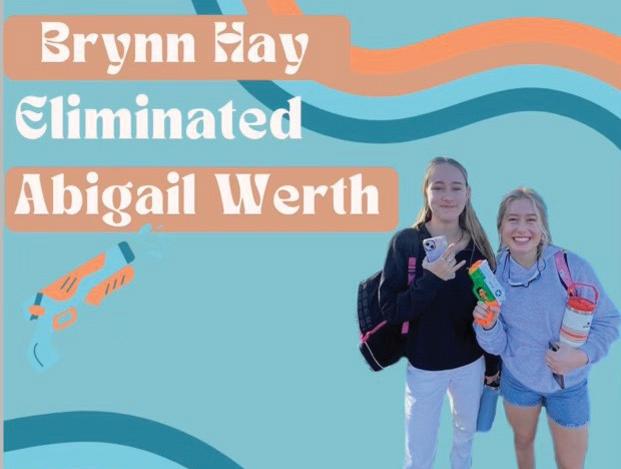
07 THE FLASH
Misused and Abused
The smell of artificial fruit from a vape. Toilets clogged with paper towels, food, and even a tree branch. The foul odor of someone not cleaning up after themselves. That’s the sight people get when they walk into a recently vandalized school bathroom. Some students here at Rocklin High School (RHS) have decided to treat bathrooms as a destructive playground, wrecking fixtures or making them so disgusting that students avoid using them. Custodians, students, and faculty here at RHS are affected by this behavior on a weekly basis, and many have formed concerned opinions on the issue, from where it started to how to deal with it.
The custodians are the ones who are most affected by the bathroom vandalism.
They regularly come into contact with vandalism because they clean the bathrooms for everyday use. Lead custodian Felicia Guadiana said that they have to deal with damage at least “once or twice a week, if not more ….” She talked about custodians even having to deal with foreign objects in the plumbing, such as combination locks and even “a tree branch… they pooped inside the toilet and then put the biggest tree branch inside the toilet as well.” This, however, hasn’t deterred the custodians from trying to care for the bathrooms, as they openly try their best to create a safe environment for the school. Ms. Guadiana said that it is “not embarrassing because we want you guys to have a clean and safe environment to go to the restroom … that’s our job here to make sure that you guys have that clean environment ….”
Students here also feel discouraged by

we want you guys to have a clean and safe environment to go to the restroom “ “
the vandalism. Many have seen or heard about lots of inconsiderate conduct in the bathrooms. Junior Pawni Tawari said that they smell ”disgusting and part of it smells like weed or drugs. I have seen people smoke in the bathrooms before or there is writing on the stalls.”
Other students have noticed that vaping in the bathrooms is becoming a common occurrence. Freshman William Probus said, “Most often I see it during breaks like brunch or lunch.” Dealing with the effects of vape odors, clogged toilets, unstable sinks, and vandalism has caused many students to feel fed up with the state of the bathrooms. Probus said, “People need to take care of school bathrooms better.”
The administration has the burden of dealing with the funding side. A lot of the damage, from the removal of soap dispensers to the clogging of the toilets, costs money to fix. VIce principal Mark Douglas pointed out that when bathroom equipment has to be replaced due to shutdowns “we automatically do not have money for things that we want to do in a positive way on campus.” The administration has taken steps to lessen vandalism, even going so far as to shut down one of the bathrooms because it was too wrecked. Mr. Douglas said, “It’s just embarrassing when that is a problem on campus that we have to address … that is just something that shouldn’t happen, and we should be better than that.”
This brings up a necessary part of the conversation, how to fix the problem. Some new ideas are being considered,
Cole McCoy
and new measures are being taken. Ms. Guadiana said, “If we didn’t release so many boys at once from classrooms and/or not monitor, when they’re supposed to be in class … that would help if we cut that down a little bit.” Ms. Guadiana also stated that several disciplinary techs have been working well with the custodians to keep the restrooms somewhat in order. Some drastic actions have been taken, such as both C bathrooms shutting down. Mr. Douglas said, “... we’re not allowed to have the bathroom open unless we have all of those things available in the bathroom.” There is some debate on how much monitoring should be done and at what times, however it is clear that everyone, from the administration to the students to the custodians, is fed up with the vandalism.

Scan this QR code to go to our Video Podcasting channel Live from M-5, and listen to the podcast for Misued and Abused
Story by: Jason Cardanini, Editor-in-Training
Design by: Bailee Sexton,
Editor-in-Training
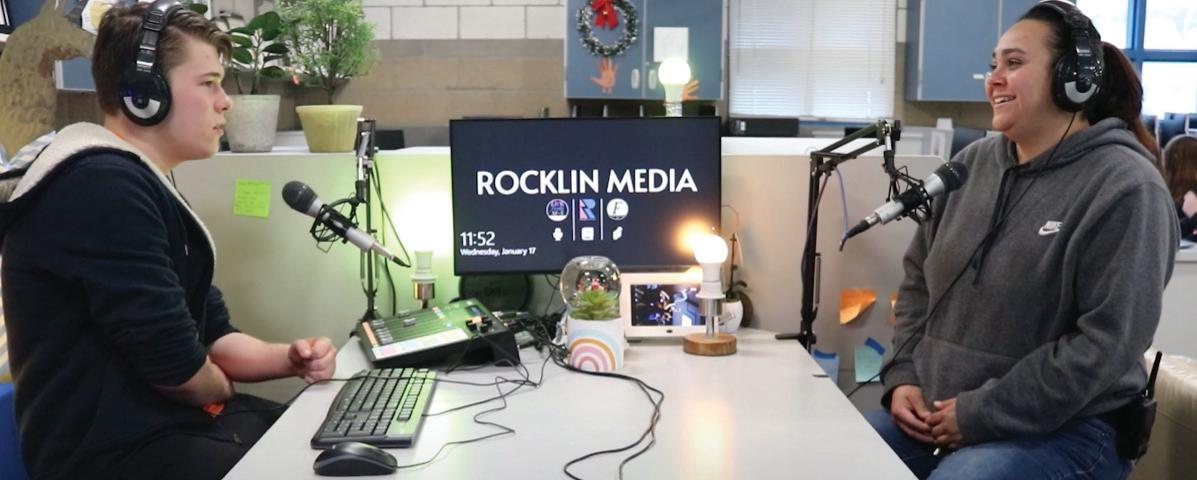
Data found on AP News, “Vaping by high school students dropped this year, says US report.” And FDA report, “Results from the annual National Youth Tobacco Survey.”
Teens that vape a least once a day
10%
Teens that used e-cigarettes last month
25%
THE FLASH 09
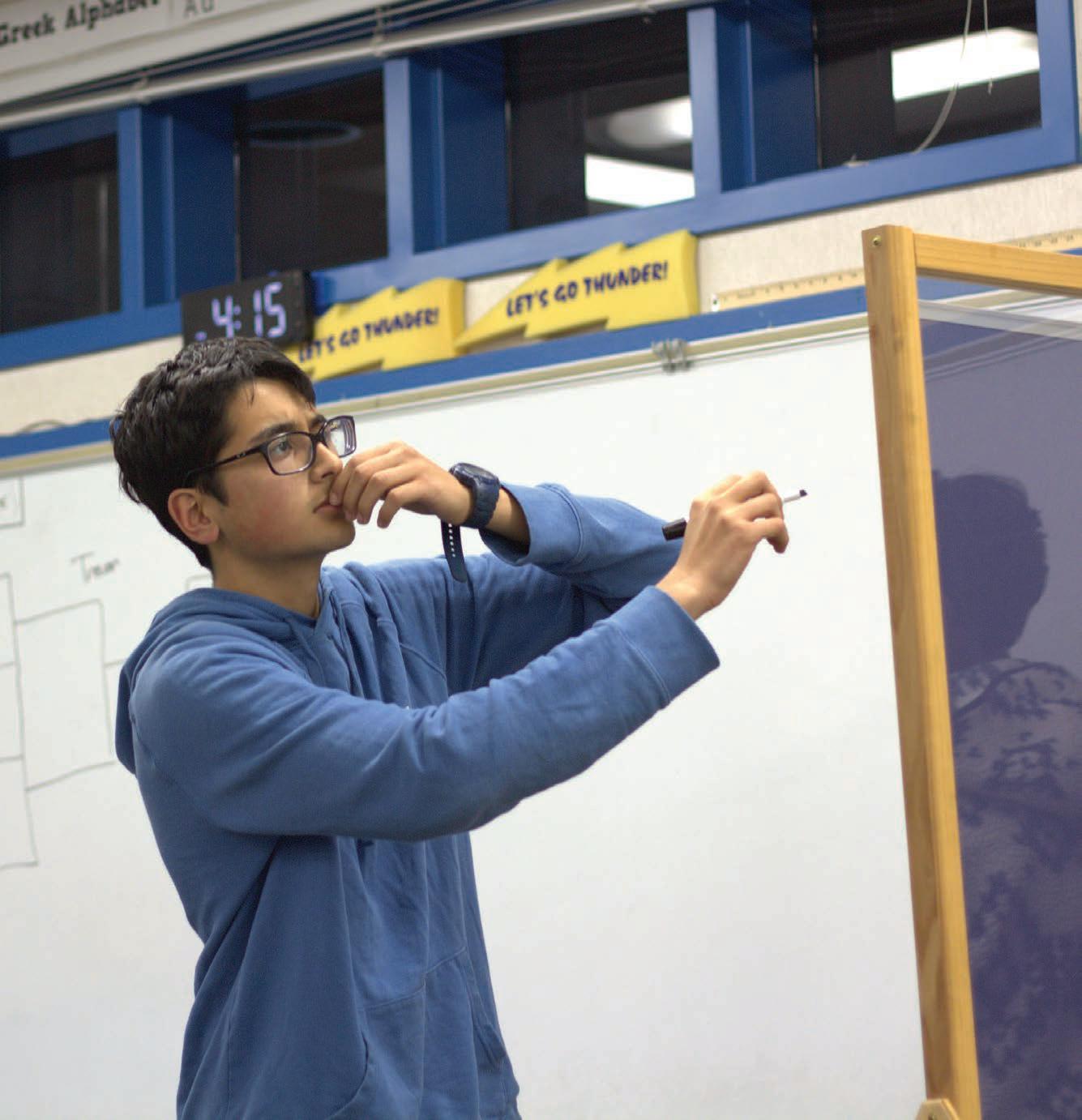
CALCULUS math skills to
“The problem of really good questions doesn’t come from it being tedious to carry out, but rather requiring some kind of higher level thinking or insight in order to solve the problem,”
The competitors race to their whiteboards and begin to copy down the complicated calculus problem projected on the screen, glancing over their shoulders now and then to make sure they have it right. They are separated by a tall divider so that neither can see the other’s work, but the audience can watch both as they begin to write at a furious pace. The atmosphere is tense — this is the round that will decide the winner of the first annual Rocklin High School (RHS) integration bee.
Organized by RHS juniors Mateo Lopez and Rishabh Bhutani, the integration bee was a two-day calculus competition that consisted of a paper qualifying exam administered during Flex period on February 27 and three knockout rounds held after school on March 1. In the final match, junior Si Stagg claimed a narrow victory over sophomore Aryavrat Mishra,
taking home $100 and a textbook.
Modeled after the MIT integration bee, the event was intended to give RHS calculus students a way to showcase their skills in the spirit of friendly competition. “It was pretty challenging,” Stagg said. “All the matches were really close and the time was pretty short and all the integrals were pretty tough.”
- Mateo Lopez
problems used in the competition. “The difficulty of really good questions doesn’t come from it being tedious to carry out, but rather requiring some kind of higher level thinking or insight in order to solve the problem,” said Lopez. “So many problems that I make are inspired by other things that I’ve seen because coming up with an original idea is just very difficult. But sometimes I do have just an inspiration and I just try using what I know about functions to make it work.”
Bhutani said that the questions were designed to favor creativity over speed. “We believe that integration is kind of the culmination of calculus because it combines so many skills and a lot of things really come together and there’s a lot of creativity that goes into very difficult integration problems,” he said.
Lopez and Bhutani created all the
In addition to the effort that went into making the problems, the bee required a significant amount of planning. Lopez and Bhutani visited each calculus class to collect sign-ups and arranged for the qualifying round to take place in AP Calculus AB teacher Tara McCullough’s room during Flex. In the end, 23 students took part in the competition, and eight advanced to the knockout rounds, which were hosted by math teacher Michael

The problem of really good questions doesn’t come from it being tedious to carry out, but rather requiring some kind of higher level thinking or insight in order to solve the problem,” - Mateo Lopez
Trejo. Pizza and beverages were provided to all contestants and audience members.
Mrs. McCullough said, “I thought there was a lot of interest, I was really happy to see that. And not just the BC class, but my class and even some kids that aren’t taking calculus at all right now.” She also said that the level of difficulty should “come down a little bit just to make it more accessible to more students.”
Based on feedback from a participant survey, Lopez and Bhutani are planning to reduce the time pressure for next year’s knockout rounds. “Especially during the quarterfinals, a lot of people were pres -
sured by the clock and they made some small mistakes,” Bhutani said.
Stagg likewise found the knockout rounds to be more difficult because of the pressure. “With the time pressure, it’s like you got so many different thoughts coming together, while on paper you can kind of plan things out more accordingly and come across a solution,” he said.
Overall, Lopez and Bhutani received positive feedback and are planning to host another calculus competition in May or June. Lopez said that he hopes future leaders of the Math Competition Club will continue to hold annual integration
bees even after he graduates and make the event “an enduring tradition for Rocklin High.”
Story by: Radian Hong,
Editor-in-Chief
Design by: Cassiopeia Le, Editor-in-Chief
11THE FLASH

Sleaze
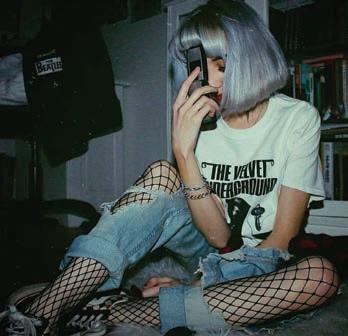

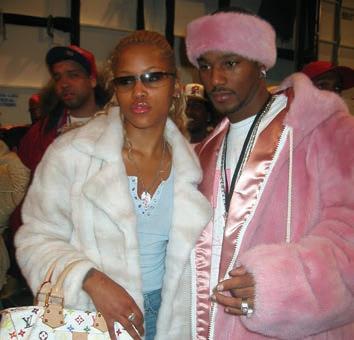
OOPS! I Did It Again
The 2000s-2010s are coming back. Do we really want that?
Widely across social media, there has been a revival of the 2010s. IPhone 6s, bright colors, and Victoria’s Secret Pink girls have recently begun to revive themselves on social media. But why has there been such a surge for the last two decades, and what parts of them are being revived?
One notable aesthetic resurfacing is the “Tumblr girl” which falls under the umbrella of Indie sleaze. Brands like American Apparel brought a shine to that style during the 2000s. Mandy Lee a Trend cyclist analyst tells Vogue, “Indie sleaze was much more flamboyant; neon colors, metallics, ostentatious displays of nightlife, erotic advertisements, and amateur-style flash photography. Indie sleaze became more popular during the MySpace era of social media, which later gave rise to the edgy Tumblr Girl in the 2010s. Those nostalgic aesthetics we know have two things in common, they had a rebellious motive and a materialization through music.“The rebellious motive came about when girls’ societal standards began to change, and body image began to get challenged.
The Trashy Y2k era is also making a comeback. Ultra low-rise jeans, bright, hot pink, cheetah print, and bedazzled everything are some key points in recognizing that aesthetic. Quinn Halbower, a junior at RHS states, “Any shirt that has crosses or diamonds I resonate with the most. Anything McBling I love.” The Trashy Y2K era was heavily based on bright colors and flashy accessories. “I like the low-rise, with the cheetah print, hot pink, and big necklaces,” said Halbower. This era had some amazing fashion statements, but also some flops as well. “I don’t like capris and skinny jeans, I like them sometimes but not always,” said Halbower. Brynn Bryans a
junior from RHS says, “I don’t love layering, it looks good if it’s one lace shirt. It can kind of look dumb, like you’re in sixth grade and you’re mom said you couldn’t wear a crop top.” Many fashion trends from the 2000s are incorporated into Disney Channel, with quirky teenagers like Lizzie McGuire and Hannah Montana wearing layered shirts, capris, statement necklaces, and side bangs.
“I feel like back then the message wasn’t great but it’s so much worse now.” -Quinn Halbower
Other popular trends coming back are the VS (Victoria’s Secret) and LA girls. These aesthetics incorporate a lot of short denim jeans, tank tops, off-theshoulder tops, and light colors. Think of brandy Melville, Victoria’s Secret, Abercrombie, Hollister, and those typical American teen stores. Bryans said, “The femininity that people are bringing back into their clothing, back then I feel like it was kind of showed that you were confident in your femininity,” as shown in recent trends. Girls who embodied this aesthetic used Instagram filters and religiously followed Bella Hadid and Adriana Lima. Now this is closer to the 2010s than the 2000s and many of Gen Z are closer to this aesthetic alongside the 2014 Tumblr girl. There isn’t a specific name for this aesthetic however many resonate with this, as aspects of this aesthetic have been incorporated into the more modern “clean girl aesthetic.” The clean girl wears fitted and
2000s-Indie
REBEL CIRCUS
2010s-Tumblr Girl
2000s-McBling Y2K VOGUE
NIEHXUS
2010s-LA Girl PINTEREST
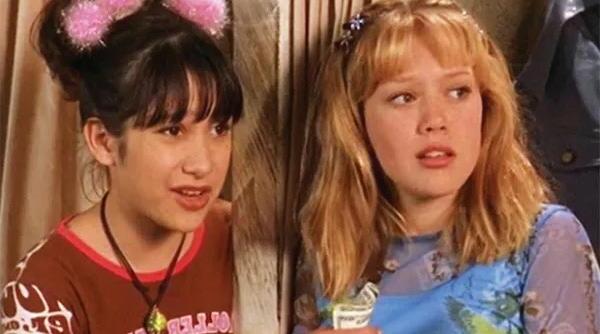
off-the-shoulder tops, taps into her femininity, and is comfortable in her body.
Music from 10-20 years ago is coming back, and many are turning back to the basics. Popular artists from the 20002010s include Britney Spears, Usher, Lady Gaga, Kesha, 50 Cent, Eminem, and more. Britney Spears was a pop icon and influenced many styles to come back from the 2000s nowadays, such as low-rise jeans, flashy tops, and stilettos. 50 Cent and Eminem are closer to rappers, while Usher is regarded as an American musician, but is mostly known for his R&B and pop music. The music has changed throughout the decades and rap, R&B, and pop music have evolved throughout the years, and some believe negatively. Bryans said, “Negative, the way that people sing about people. The way men sing about women now, why are you talking about having 6 girlfriends at once.” Halbower adds, “I feel like back then the message wasn’t great but it’s so much worse now.”
“I feel like back then the message wasn’t great but it’s so much worse now.” -Quinn Halbower
Compared to the 2000s, arguably the 2010s promoted more body positivity, challenging societal standards for girls, and wearing light and feminine clothing, in some notable ways. The 2000s created many eating disorders in young girls, as teen magazines gave diets and wrote articles about diets for girls to be “model-like”, inspired by Kate Moss’s famous quote, “Nothing feels as good as skinny feels.” “1 million percent, that style does promote an unhealthy body standard,” said Halbower.“ Theres a lot of people that will always have to comment,” added Bryans. American corporations also followed this eating dis -
order trend, to which Kellog’s made a famous ad stating that “you could ‘drop a jeans size in two weeks” when you re place two meals out of your day with Kellog cereal (The New Feminist).
Now how will these trends translate into our society today? Will it con tinue to promote eating disorders or not? Considering the societal norms in America, many girls can still be subject to eating disorders if they at tempt to embody the trends exactly from the 2000s and 2010s, however, if girls are exposed to many differ ent body types as well as healthy body types, then the aesthet ic can be achieved without starving themselves. There has been a recent change to body positivity, and feeling comfortable in one’s skin de spite not being a size 0. Diversity in models both racially and by body type has increased throughout the years. The Luxiders Magazine states, “ The body positivity movement and body positivity activists in the fashion industry play an important role in changing how people view their bodies.”
By: Milana Kozlova, Editor-in-Chief
Right: Pop-Star Britney Spears during her “oops! I Did it Again” concert in one of her famous “space suits.”
Bottom: Clip from a 2000s show “Lizzie McGuire”, which showcases the numerous fashion and music trends of the 2000s throughout the show
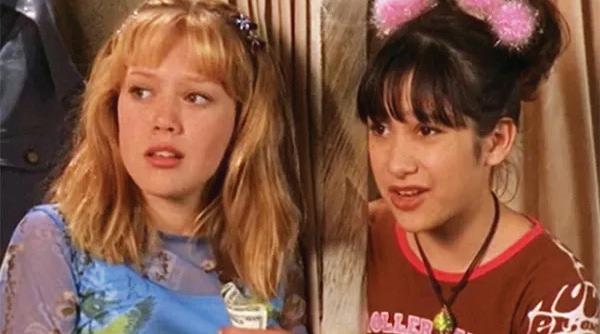


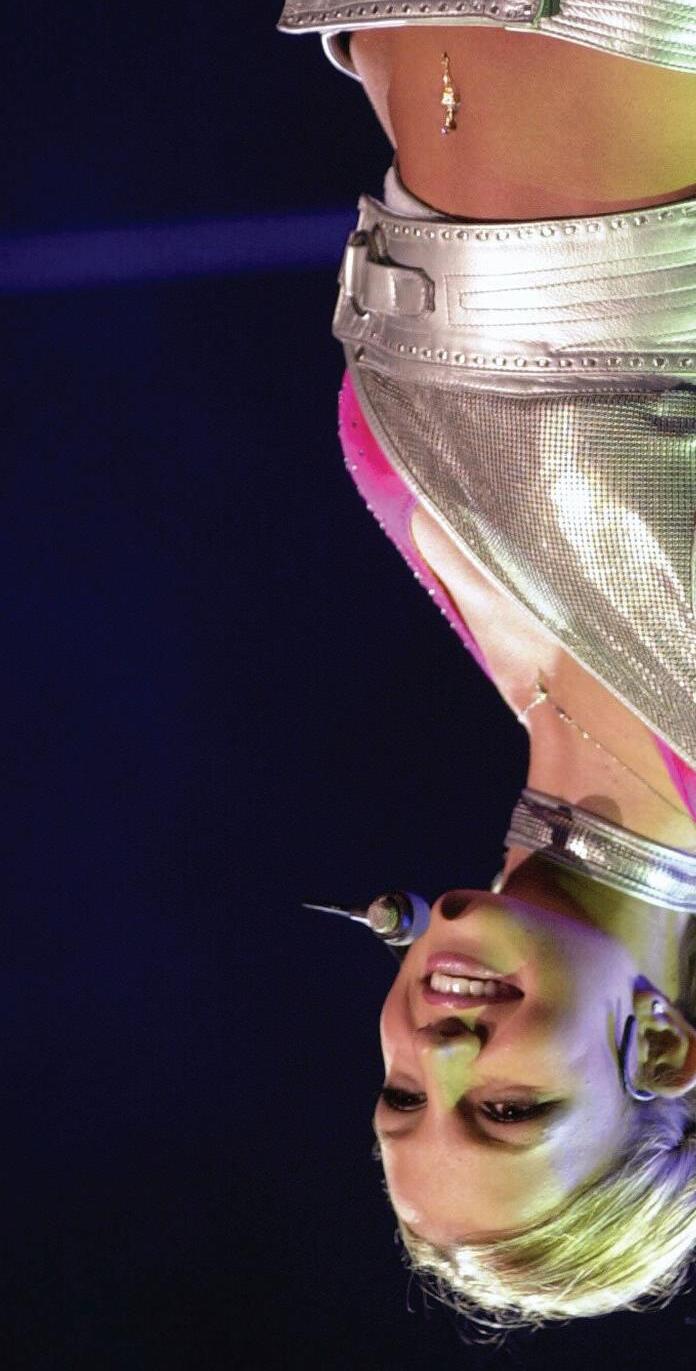
13 THE FLASH CHANNEL 2014.spread.milana.indd 3 5/29/2024 3:50:55 PM
UNDERDOGS

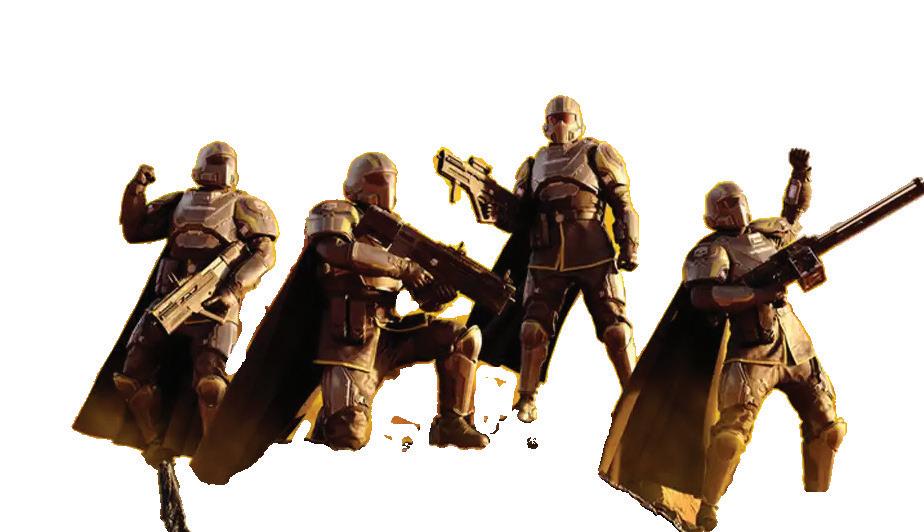
Small companies are taking over the gaming industry
The craze started in the 70s, became popular in the 80s and 90s, and grew during the 2000s and 2010s. Now it is one of the most influential entertainment industries out there. The gaming industry has gone from a small-scale form of entertainment to a pastime loved worldwide. It is now in a period of transition in communities and companies. Since the 2010s, big, well-known gaming companies have had the most control and popular games on the market, but that monopoly created stagnation. This, however, began to shift in the past few years to a focus on lesser-known and smaller companies that are now producing more popular games than the original titans of the industry. The lack of triple-A games this year hasn’t helped, resulting in a loss for the giants of gaming. Many people have given their opinions on why small and lesser-known companies are gaining more revenue, why bigger companies aren’t doing as well, why there are so few big releases this year, and how all this will affect the gaming
industry.
Over the past year, small or less notable gaming companies have been gaining critical attention, with games like “Palworld” and “Helldivers 2” being heavily played. “Palworld” sold over 25 million copies in just over a month on many platforms. Elias Wylie, a student at Rocklin High School (RHS), said one of the reasons for this is that “they have just good game design where people liked them so they got popular.” Many indie games are praised for their creative design and gameplay, which has captivated and enthused many. Emily Passanisi, a junior at RHS, said ”I’m pretty glad these games are getting attention because I think it’s very important to support smaller creators and I think they have the potential to make it big in the world.” Many people believe that these small games getting more attention is a great opportunity for the studios and even the industry as a whole.
But that brings up another question: what has happened with the bigger and more established studios that caused them to fall behind smaller developers? Over the past few years, big game studios like EA and Bungie have been struggling to keep up profits and community support, with games like “Suicide Squad: Kill the Justice League” and “Destiny 2: Lightfall” receiving mediocre to horrible reviews. One of the biggest reasons for this to many is the heavy reliance on microtransactions in modern gaming. Passanisi said, “It almost feels like they are trying to farm
“It’s just continuously pushing out content ….
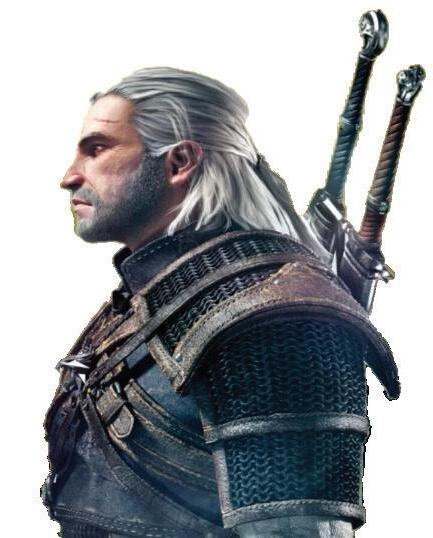
for content. It’s just continuously pushing out content. … I feel the big companies are putting too little time into their games because they just want to push it out so that there’s content out there. They don’t really care about whether people think it’s good or not, but rather that people are going to buy it, and they just care that people are investing their money, not their actual interest.” Another reason could be due to the amount of incomplete games by major studios. Several big games, like “Cyberpunk 2077” and “Jedi: Survivor” were released in very glitchy, unpolished forms, and though some of the issues have been fixed, it still affected their reputation and the amount of people who played. Overall, the bigger studios are facing backlash and financial trouble due to the large amount of flaws and incomplete products they’ve been releasing.
But that’s not the only issue people have noticed — there’s also been a lack of major releases announced this year. Compared to 2022 and 2023, there’s been a surprising dry spell of big game releas es, with many being remakes or DLCs like “The Last of Us Part II Remastered” or “Elden Ring: Shadow of the Endtree.”
There’s also been a lack of specific dates for releases, with many games like “Little Nightmares 3” or “Star Wars Outlaws” not having any release dates besides this year. Joshua Rubenstein, a teacher at RHS, said a reason for this might be “because the graphic levels that we’re at now and sound design and story design require teams of 20, 30 people in each of those areas working for years, I think it actually does lend towards major studios getting
bogged down.” Game companies have also been increasingly laying off their employees, with more than 8,000 people laid off in January and February alone. With the large amount of time it now takes to make big games coupled with a high number of layoffs in the past few years, it’s no surprise that there aren’t as many big game releases as there were before.
This all relates to the biggest question: how will this impact the gaming industry? There’s a surprising amount of people feeling optimistic about the future of gaming. Many are in support of smaller game companies getting more attention. Passanisi said, “I definitely think it’s a vital year. If the smaller game companies are realizing what’s going on, they can definitely use this to their advantage to get some attention towards their games.” Others are okay with bigger games not being released as often. Mr. Rubinstein said, “I’m okay with major studios having to take their time to deliver a “GTA 6” or something like that if it means there’s a quality game at the end of it.”
Story by: Jason Cardanini, Editor-in-Training
Design by: Olivia Cruz, Staff Reporter

15 THE FLASH
All in the Details
A glimpse into the mind of a computer programmer on campus

Thin bars of varying height dance across the Chromebook screen, accompanied by what to me sound like classic computer bleeps and bloops. I don’t know what I’m watching, but whatever it is is strangely mesmerizing; the sounds grow faster and faster and, gradually, a gradient pattern surfaces out of the randomness.
Senior Ryan Schuett points to the screen, explaining the difference between stable and unstable sorting algorithms. Those flickering numbers and shifting bars obviously mean something more to him than a light show, and his enthusiasm makes me want to know what it is. He is happy to explain. Despite all the technical jargon he uses, I gradually begin to understand what I’m seeing. Those white bars represent numbers, and the program is arranging them by size.
On my second meeting with Schuett, I had asked him to show me one of his recently completed projects, a sorting algorithm visualizer. Unlike many previously existing programs, his is entirely web-based and is accessible with virtually any device — even a Chromebook. As we sat outside the school library, he navigated to the list of algorithms on the site. “One of my favorites is partially combed, but random shuffle is the classic one, so I’ll just show you this,” he said.
A sorting algorithm, he explained, is a computer program used to arrange data by some value. For example, one could sort a randomized list of numbers by their size. Although it may sound straightforward, there are a surprisingly large number of ways to go about performing this task, each with its own set of benefits and drawbacks.
Schuett spoke deliberately as he described
RADIAN HONG
Pictured: Ryan Schuett outside the RHS library
“I have a vision in my mind for what I want it to be, and seeing that come to fruition is part of the thing that is so exciting. Seeing that happen over time will keep me engaged for an entire day.”
the fine differences between the different types of sorting algorithms, pausing every once in a while to make sure he used the right word or correcting himself if he said something not technically accurate. Gesturing with both arms, he described the trade-offs in memory usage, efficiency, and stability that go into choosing which algorithm type to use. “You could have it be n times logarithm of n, you can have it be stable, and you can have it not use auxiliary arrays. But you can only pick two,” he said.
One thing that stuck with me from my very first meeting with Schuett was his love for efficiency. Although he can program in a wide array of languages — C#, JavaScript, Python, Java — his favorite is C++, an older language known both for its difficult syntax and for its speed. He proudly told me about a script he worked on for his IT Essentials class. It had initially taken about a minute to run, which to many people might seem good enough. He managed to reduce the run time to about two seconds.
Iwas surprised when Schuett told me that he is taking his first computer science class at RHS just this year, given his success in competitive programming; his team had come in second place in the advanced division at the HPE CodeWars competition in Roseville and first place internationally at the CodeWars Open Beta. It turned out that he was mostly selftaught.
Schuett got his start in web development when his parents enrolled him in Hackingtons, a coding school for kids. After he left, he began to teach himself how to program console applications by watching tutorials and through trial and error. For instance, he learned how to use the runtime environment Node.js in the process
of building his own Discord bot.
The amount of time he spends programming each day varies widely; on some days, he told me, he spends all his time playing games with his friends and doesn’t touch his projects. On others, he spends upwards of ten hours working on code. “I have a vision in my mind for what I want it to be, and seeing that come to fruition is part of the thing that is so exciting. Seeing that happen over time will keep me engaged for an entire day,” he said.
He sometimes gets frustrated and has to step away from a project when his vision turns out to be incompatible with the code he has written, but because of his thorough debugging process, he couldn’t tell me the last time this happened. “As soon as I have a certain feature in, I go into QA tester mode and I test it and figure out any problems with it that I can see by testing it over and over again,” he said. “And then if I find a problem, I’ll fix that as I’m developing the feature.”
Lastsummer, Schuett did a paid internship at Pacific Coast Building Products. He built a prototype of an AI model that communicates with the company database and makes predictions that he hopes will eventually factor into business decisions. “Once I actually complete a project, seeing it be functional, seeing it be used by people, and seeing people enjoy it, that’s the thing I love about doing these projects,” he said. He returned to the same company for another internship over winter break and plans to go back again this summer before he starts college at Sierra as a computer science major.
Being able to stay at home while working to earn money is one reason Schuett chose to go the community college route, in ad-
dition to the free tuition. Another is his GPA. “I have a habit of not quite doing my homework here,” he told me with a grin. It isn’t that he doesn’t like school, he said — he just prefers to spend his free time working on his programming projects rather than completing homework assignments. He does hope to eventually attend a fouryear university and pursue a degree in a computer science-adjacent field.
Schuett’s love for programming comes down to a love for problem-solving. “Programming isn’t completely technical,” he said. “For example, Python is much closer to human speech than some other programming languages. The toughest part about programming that many people just don’t understand is that it’s mainly logical. It’s all about the logic.”
The bleeps and bloops reach a fever pitch and then abruptly die out. What is left is a staircase pattern in which each step is a gradient. “Bubble sort is a stable algorithm because it produces this nice gradient. The white one means it was near the start and the gray means it was at the end. And so it remains in the same order that it was before,” Schuett says, and I finally begin to get it. “It’s really fascinating,” he says. “There’s a lot of YouTube videos about this kind of stuff, but I just wanted to make one of my own.”
By: Radian Hong, Editor-in-Chief
17 THE FLASH
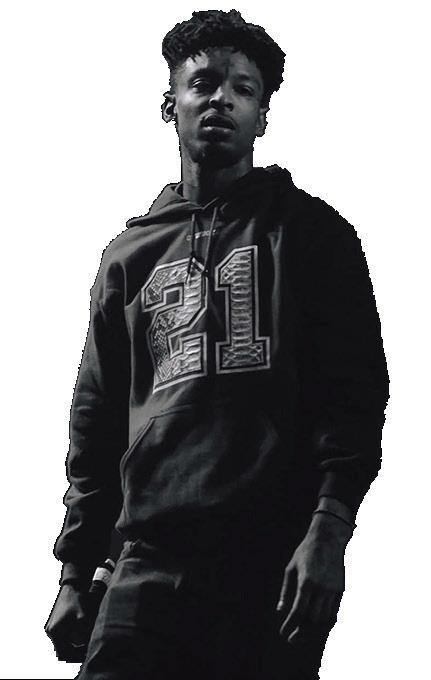
THE RAP EFFECT

New school or old school? Fun or intimate lyrics? Severe or upbeat tone? These ques tions prove how diverse one of the most popular genres of music can be. There are so many cultures surrounding rap that make it what it is today. The transparen cy of the artists is reflected in their mu sic, the stories behind it, and the artists themselves. But how do these key ele ments affect teenagers in their daily lives?
Although rap is seen as incredibly con troversial, according to Statista, 48% of teenagers ages 16 to 19 reported that one of their favorite genres of music was rap or hip hop. The most disputable char acteristic of rap music is the lyrics. Al though some are extremely vulgar, many are personal and heartfelt. Called the King of Rap, Eminem has a unique talent for writing intensely personal and relatable lyrics, often drawing from his life experiences and emotions. “I think knowing Eminem’s background and just the way he presents himself makes his music have a history that’s like no other,” said sophomore Brenna Radmand. “He is a true artist.” This form of transparency can teach teens today to be open about their feelings in any form they choose — whether creative or not. Radmand went on to say that she “never really thought [Eminem] was controversial, but everyone likes to hate on something. When these people see a white rapper writing ‘black people music,’ it can put an easy target on his back.”
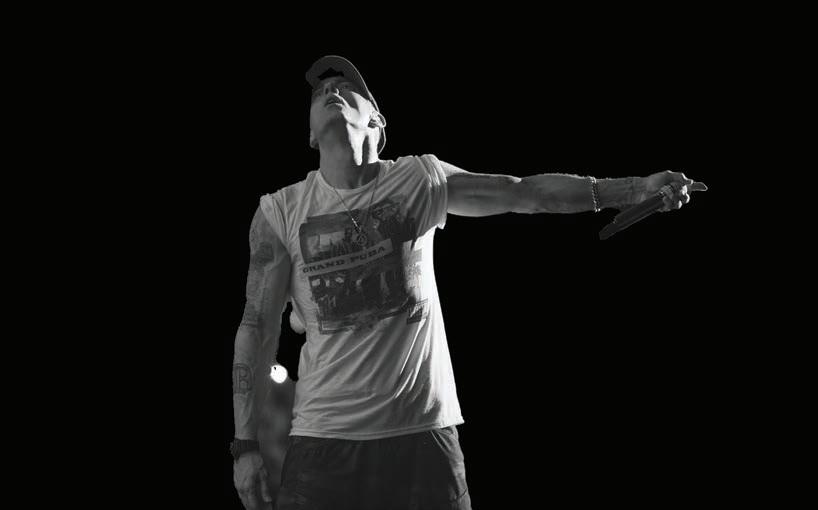
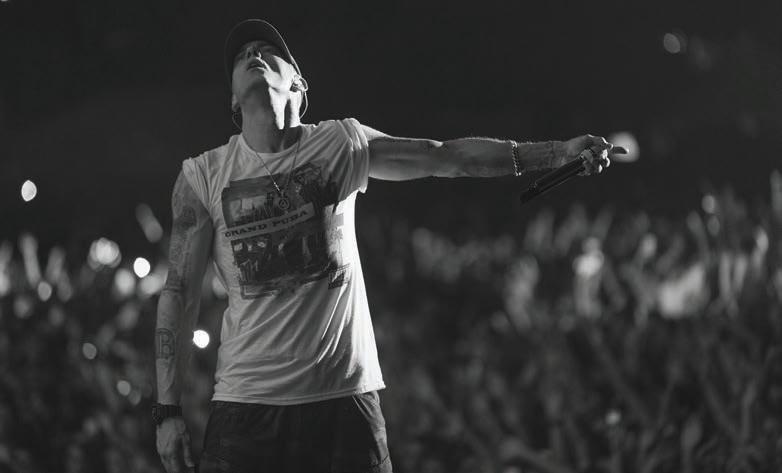
Research shows that rap songs can trigger parts of the brain that control emotion, language, and overall motivation. People who listen to rap music have been found to cope with mental health issues much better than others. This is all due to the way that rappers and listeners express themselves, just as stated earlier.
Some of the favorite artists among multiple high school students include 50 Cent, J. Cole, Eminem, MF Doom, D12, Drake, Kendrick Lamar, Travis Scott, Tupac, Dr. Dre, and 21 Savage. All of these are culturally significant figures appreciated by many of your peers. So now, the real question is... how does rap influence you?


Nowadays, many of the lyrics of these songs are ostentatious. Approximately 22% to 37% of all rap music has been found to contain some misogyny. Again, these lyrics can affect teenagers’ actions or provoke them to do something they normally wouldn’t. Junior Jared Buetzow claims that he “tries to tune out the lyrics or ignore what they’re actually saying ….” He said, “I may not agree with what they’re saying, [but] it’s their art, not mine. It’s my choice to listen.” This take is shared with many listeners of all ages, believing that freedom of expression is the most important aspect of the genre itself. A lot of this music is built on interpretation, such as how the music makes you feel or how you apply those lyrics to your life. Brenna believes that “the music includes a lot of lyrics about love and being loyal to your significant other, which is pretty important.” Are you confident that the music you’ve been listening to is in line with your personal values and beliefs, especially if you feel strongly about them? And even if they don’t, do you still try to really understand what the songs are saying? Your influences do not always have to directly affect how you look, act, and feel. Rap music is an exceptional medium for conveying emotions and exploring the vast pool of talented artists in the music industry.
Written by Bailee Sexton, Staff Reporter



FORM OF - Brenna Radmand Student’s rap playlists (may contain explicit material) IT’S A
ART
19 THE FLASH
The ethics of AI by students in classrooms Decoding the Classroom Dilemma

As classrooms around the world increasingly embrace technology, the integration of artificial intelligence (AI) into educational settings has sparked a complex debate. Educational institutions are exploring how AI tools such as adaptive learning systems, personalized content algorithms, and AI-powered tutoring bots can transform teaching and learning processes. While these innovations promise a range of benefits, they also bring forth significant ethical concerns and potential downsides that educators and policymakers must carefully consider.
Advocates for AI in education highlight its potential to personalize learning in unprecedented ways. AI can analyze individual learning patterns and tailor content to suit each student’s unique needs, potentially overcoming the one-
size-fits-all approach often criticized in traditional education models. Mr. James, a Rocklin High School senior language arts teacher, thinks “AI may well prove to be a valuable tool in the classroom that has the potential to enhance learning.” AI tools also promise to enhance accessibility in education. For students with disabilities, AI can provide specialized assistance through voice recognition and other adaptive technologies, making learning more accessible than ever before.
Dr. Emily Thomson, an educational technology researcher at the US Department of Education, argued, “AI can drastically improve the efficiency of learning by identifying students’ weaknesses and providing tailored support.” Such technology not only aids in closing knowledge gaps more quickly but also empowers students
An AI generated image
by allowing them to progress at their own pace, thereby fostering a more inclusive learning environment. Mr. James said, “We are only beginning to understand the ways that AI might enhance learning. I can imagine that AI might be able to provide extra help to students with papers, projects, research, revision, editing, etc, almost like a tutor ….”
Furthermore, AI-driven programs can handle routine educational tasks such as grading and scheduling, freeing up teachers to focus more on classroom interaction and less on administrative duties. This shift can lead to a richer, more engaged learning experience for students. Despite these advantages, the use of AI in classrooms is not devoid of challenges. One major concern is the potential for AI to depersonalize education. Diego
Nunez, a senior at Rocklin High School, said, “there is a risk that AI could replace essential human elements that are critical for students’ emotional and social development.” The nuances of human interaction such as empathy, moral reasoning, and social cues may not be adequately captured by AI, potentially stunting students’ interpersonal growth. Mr. James said, “... AI is not used as a shortcut to bypass learning, that it does not interfere with students developing the capacity to think for themselves, and that AI is used in an honest and transparent way (cited in student work much as we do with other sources).”
a learning mindset vs a task completion mindset.”
Decoding the Classroom Dilemma
An AI generated image
Privacy and data security are additional concerns. AI systems require access to vast amounts of personal data to function optimally. This raises questions about who owns this data and how it is used, particularly when it concerns minors. The risk of data breaches and misuse cannot be ignored, necessitating robust safeguards and transparent policies to protect student information.
Equity issues present another ethical challenge. AI implementation requires significant investment in technology and training, resources that are not uniformly available across all educational institutions. This disparity could widen the gap between well-funded, typically suburban schools and under-resourced rural or inner-city schools, exacerbating existing inequalities in educational outcomes. “While AI has the potential to enhance learning, it also risks exacerbating educational inequalities,” Nunez added, highlighting the need for careful policy planning to ensure equitable access to AI benefits.
“We need to be clear about our expectations for using AI as a tool to deepen learning rather than as a way to avoid the work,” said Mr. James. “For example, asking AI for suggestions about different ways to structure a persuasive argument would perhaps be an acceptable use, whereas asking AI to complete the assignment for you would not. It’s about
While AI in education offers exciting possibilities for enhancing learning through personalization and increased accessibility, its adoption is fraught with significant ethical, interpersonal, and equity challenges. The deployment of AI in educational settings demands a balanced approach that harnesses AI’s benefits while vigilantly addressing its potential imperfections. As this technology continues to evolve, it will require continuous communication among educators, technologists, and policymakers. This collaborative approach will be crucial in developing strategies that leverage AI’s strengths and ensure it serves as a tool for enhancing educational outcomes fairly and responsibly across all student demographics.
Story By: Lexi Booras, Staff Reporter
Design By: Bailee Sexton, Staff Reporter
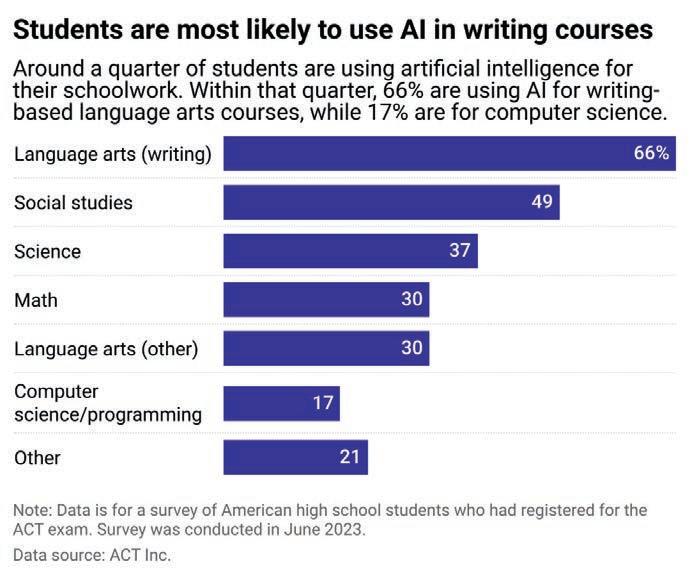
STACSKER 21THE FLASH
What does your faith mean to you?

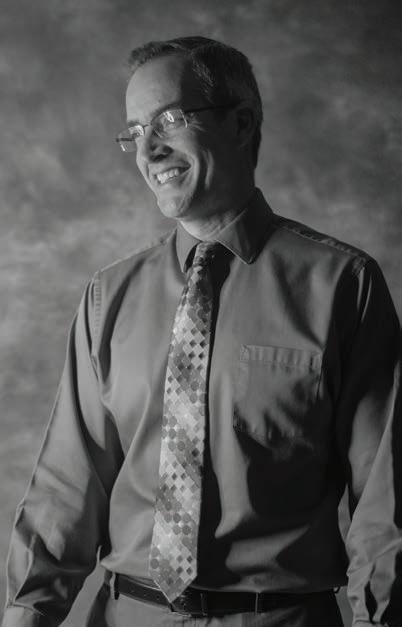

In a “Humans of New York” style, Rocklin High School staff and students explain the role religion plays in their lives.

Ibraheem Tariq, Muslim:
“To me, faith is being able to understand that you aren’t self sufficient. Islam, it gives you humility because everything in your life, everything that happens isn’t because of you. It’s because of a greater power that you choose to believe. And it just also gives me some security that there is something out there that I can put my all into and know that I will get something in return.
I do feel less Muslim some days and sometimes I feel more. It is natural to feel like you aren’t that close with God, or Allah. But it’s just important to always remember that he is with you, wherever you are. So even though you may not feel close to him, he is always with you. And just to always believe in the fact that he’s there.
Vishnupriya Govindan, Hindu:

The day is split up into five times — there is a prayer for every part of the day and the times change throughout the seasons. Sometimes in winter, noon would begin earlier and end earlier than in the summer. So in the winter, I pray at school because I would miss [the specific prayer time] if I got home. I just have a little pocket size prayer mat in my backpack, and then go to the bathroom to perform the ablution called ‘Wudu’. And then I just pray during lunch in Mr. Waechtler’s room.
For me, as long as I know the truth and I know my faith and my beliefs and my virtues, I don’t really care what anyone else thinks about me because that’s not what’s important. What’s important is that I know the truth and Allah knows the truth.”
“I am a Hindu. So my faith gives me a kind of perspective — I feel centered, balanced. My religion is very ritualistic and I try to do some rituals, like lighting a lamp, just praying for a minute or two, while I’m driving or whenever I have time, and things like that. I think it’s very quintessential for me to kind of be in that good, harmonious place every day.

I grew up in a family of faith. So it was kind of inculcated more organically with me, but at the end of the day, when you grow, you also mature in different ways. And you start asking the questions instead of blindly believing, which is what we all want to write. Because as humans, we have that intellect, the capacity to kind of discern things between the right or wrong. So I’ve had my doubts, questions, but I believe any-
thing with the intent of learning the true purpose, that questioning is good. It’s given me some clarity over time. So I have had my doubts quite a few times.
When I came to Salt Lake City, to do my doctorate, Salt Lake City had a lot of Mormons. I really appreciate their faith because we had like a friendship family with the campus who kind of took in and, like, helped us understand the culture, the Western culture, because I was even new to the country at that time. It made me think that at the end of the day, we all follow different paths leading to that same destination. We all want to be happy, healthy, and harmonious in a society. We all have different ideologies. But we can agree to disagree and that’s okay. We’re evolved humans. But I always like to appreciate what other perspectives mean and I have so many friends and we’ve had lively conversations. So its very interesting to gain that perspective.”
23 THE FLASH

Joshua Rubinstein, Messianic Jew:
“I absolutely hated Messianic Judaism. It was really hard for me to embrace my faith when I was young, because no matter who I would try to identify with, they would see me as other. Now, my faith is probably the most centrally defining reality of my life.
When I would have conversations with Jewish friends that were more traditional, they would say, ‘Well, you’re not really a Jew — you’re not allowed to believe in Jesus as a Jew’. And then I’d have conversations with Christians and they were like, ‘Oh, you’re not a Jew anymore. You don’t need to do any of that Jewish ‘stuff’. It made me different. It made me other.
Later on in my life, I remember the moment I was out doing street evangelism and this Jewish man came up to me, and spit at my feet. And he saw me and he’s like, ‘I bet you’re not even a Jew’.
And he was like, why are you out here doing this? And when he asked me that question, like, for the first time, it kind of clicked and I was like, ‘because I want my Jewish people to know that it’s okay to love the Jewish Messiah, that all of the horrible things that were done to us weren’t done to us by Him. I genuinely believe that it’s okay for Jewish people to believe in the Jewish Messiah, that it doesn’t make them not Jewish anymore’.
My faith at this point in my life has actually become one of the primary ways that I define myself as a human. I would say that there are three major identifiers of who I am as a person. One is that I am a child of God: he loves me, and I love him. That’s my first identification. My second is that I’m a husband. And my third is that I’m a father.
[My faith] shapes what kind of a teacher I am and how I carry myself on campus. So, I would say that my faith is probably even more important than my education, even more than my profession, and even more important, in some ways than my marriage. The fact that we are Messianic Jews, is of central importance. We see it as like, we’ve been invited into a relationship with God. And so it’s as if that faith then not just defines who I am in relation to other people. But that faith also defines who I see myself as in relation to God, the universe and all of humanity.
There’s nothing in who I am that’s going to prevent me from loving every single one of my students, wherever they are and who they are. And like, I don’t care what their political beliefs are, I don’t care what their social beliefs are; my job as a follower of God and being in relationship with him is that I’ve experienced His love. And I just want to love other people, because I want to bring that into the world instead of hate.”

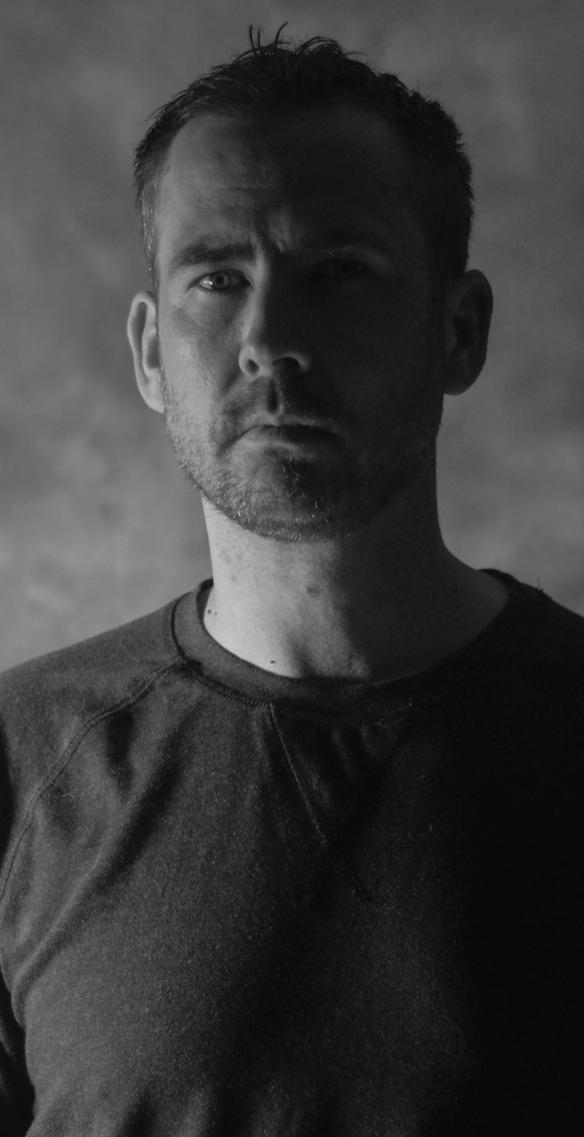
Mike Cahill, Atheist:
“My lack of faith means nothing to me. I don’t believe in anything. I think trying to define yourself in relation to lack of something is kind of absurd. Like, it doesn’t really make sense. It’s just not a part of me at all. It doesn’t have any impact or bearing on my life whatsoever.
What’s crazy is that I tried really, really, really hard to be religious. It sounds wonderful to me. Like, I really wish I could have faith to be that confident. And to be sure about what your purpose on the planet is, and to be sure there’s a reason for being and that there’s a community of people there, and we’re all striving towards something that sounds amazing to me. Right? Like, in theory, it sounds great, but I don’t have, I never could get that faith.
When I was younger, I would go to church, you know, like Protestant churches, Catholic churches. I went on a mission trip to Mexico, and, none of that did anything for me. When I was in high school, I went to a Catholic High School. And that’s when
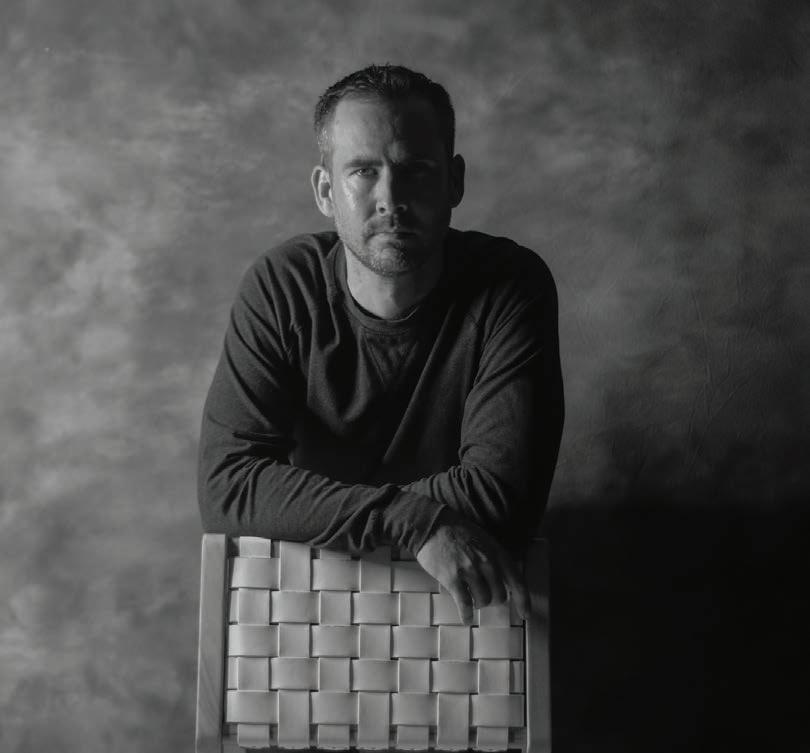
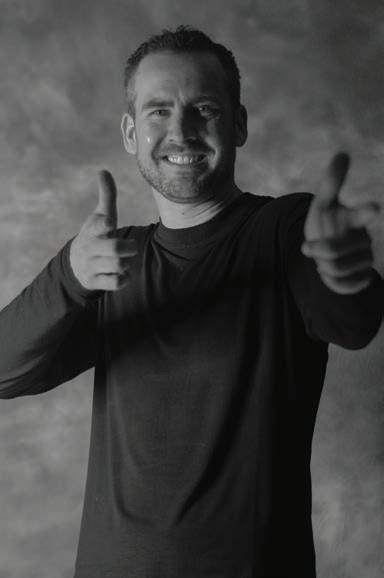
I started going and looking at Eastern religions. I started doing a lot of meditation, went into some Buddhist temples to try to see what they were about. I tried really hard, I did. And none of it fit.
The early 2000s was kind of the atheist Renaissance with Daniel Dennett, Richard Dawkins, Christopher Hitchens, and later, Sam Harris. And so seeing all those guys kind of coming out with their books, and then being able to see them talk and read all their papers was just exhilarating and eye opening for me and was like, oh, there is, not something else. Having nothing is fine.
I find religion fascinating. And that’s why I studied philosophy. In high school, when I was searching out these different religious belief structures, I realized there’s so much out there that people don’t really get to see and it’s fascinating.
When you can kind of look and go okay, there are certain inherent ideas that are inherent within each of these religions and so it’s like this beautiful community of everyone believes something different, but they all have these very similar ideas. As someone that doesn’t have any core belief system, it’s really cool to be able to, you know, just see it all as this one big beautiful painting or something. Again, as an atheist, it’s just that I am fascinated by religion and I truly enjoy hanging out with religious people.”
25 THE FLASH
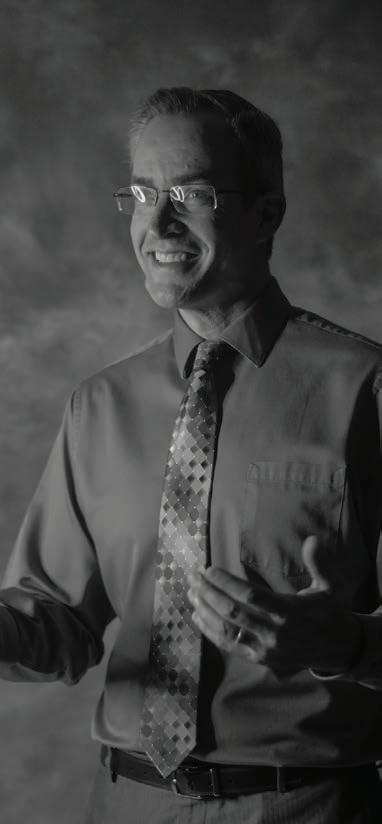

Mark Hardy, Christian:
“I didn’t grow up Christian. It was spring of my junior year when I became a believer. It started when I wanted to ask a particular girl to the prom. I said, ‘Hey, would you like to go to the prom with me?’, and she said, ‘I’ll go to prom with you if you start coming to youth group with me, at our church’. April of 1988 is when I became a Christian. And that, you know, what is that? 36 years ago?
When you say what does my faith mean to me? It’s mainly about, what does Jesus mean to me? And, I would say it means everything. It’s the most important thing in my life. It’s what drives everything that I do. It gives me motivation. It gives me hope. It gives me purpose. I’m just completely compelled by who Jesus claimed to be. And the more I investigate it, the more I look into it, the more I experience it, the more I’m absolutely convinced he is who he said he was. And that is God in the flesh.
Lately, one thing that’s been tremendous for me is that I do a lot of prison ministry. I go to federal prisons in California. And I share with them, you know, the message of salvation in Christ. And [for the] Christian believers that are in the prisons,
Cassiopeia Le, Buddhist:
“I’m not really Buddhist the way you want me. It’s like at the back of my mind and it’s not something I’m fully immersed in; I don’t know the whole history behind all of [Buddhism]. But a lot of the principles and the foundations of the religion kind of line up to how I think so I want to say that it raised me. I don’t believe in Buddhism, because it’s Buddhist, but I believe in it because my principles align with what Buddhissm teaches. I don’t think of Buddhism as a religion. I think it’s just like a way of living.
I don’t know what other way to word it, but believing and practicing the principles caused a lot of ‘character development’. I didn’t just, like, start believing in it right away but understanding the principles and

I try to encourage them in their faith to help them grow. But, yeah, once every five or six weeks, I spent an entire weekend at a prison. I sometimes go down to two different prisons, near Bakersfield, about four hours away. And I sometimes go to a prison up in Susanville, which is up in the mountains, about three hours away.
My life is driven by love, by love for God, by love for other people. And that’s what really, it animates everything that I do. And it’s what, what really kind of gets me going each day.”
why they are the way they are was important for me. I personally really believe in the principles because I think they’re just what makes a good human, a good human.
With Christianity, there’s different ways of showing off your faith, you know, like, Christians will wear their necklace with the cross. Personally, we don’t really have one for Buddhism that’s really widely known. But what I do so that I can of stay connected is a necklace that has a jade circle. That jade circle was derived from this jade Buddhist statue that my grandma had. So I wear it because it helps me feel connected a little to Buddhism and reminds me of the principles that I should live by. And that I should be a good human being and helped me feel a little closer to my grandmother.”
 By: Saraswathi Murugan, Editor-in-Training
By: Saraswathi Murugan, Editor-in-Training
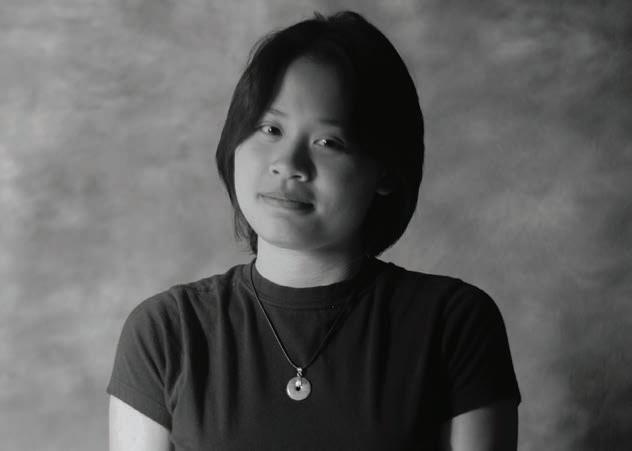

27 THE FLASH
Photos by: Olivia Ali & Saraswathi Murugan
History Through Film: Is It Worth It?
Alotof thought goes into deciding next year’s electives. Interests, classmates, teachers, and possible freeperiods are all factors. Many juniors and seniors have jobs, sports, and other extra activities, so many choose to take only six or seven classes instead of eight.
Faced with other classes such as Marine Biology, another year of foreign language, or art, many are asking themselves the question of, is History Through Film a worthy elective to take?
Senior Gideon Blake said, ¨absolutely, because it’s an easy class that is tons of fun and you get to watch a lot of good movies.¨
Blake is a Rocklin High School track and cross country star, and like many others on campus, he was faced with that same question. He said, ¨It’s a fun way to learn about history because you’re watching movies, not sitting in a lecture, and the movies are all different and expand your knowledge of what happened in history.¨
Senior Colton Wilson also agreed, saying, ¨I really suggest this class, and it’s really fun. I’ve got a lot of really great friends in there, and Spears, who teaches this class, is pretty cool, and he tells a lot of really great stories, which I like.” Wilson also added that the class is also a really good way to earn elective credits in order to
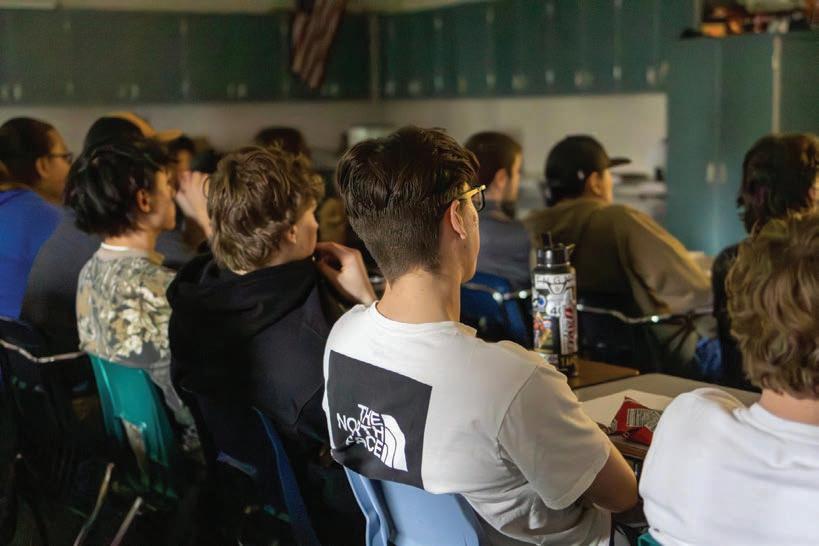
graduate.
This class is not only a good option for movie lovers, Wilson added, but also for those interested in topics such as the military or US history.
Wilson himself likes to watch movies about the military because his brother is a marine and he plans to join himself. Because this class follows US history so closely, especially through the military, it is also a way to learn history from a cinematic point of view.
So what do you even do in the class?

According to the RHS Academic Planning Guide, “The purpose of this course is to help students develop the historical thinking skill of analysis and corroboration with media and historical documents.”
Wilson remarked that in a typical class period, “after the movies we write a critique about what we thought of the movie, and we write our thoughts about it, what we felt, what historic events take place in the movie. We watch four or three movies each [quarter]. Sometimes we work on assignments. Right now we are doing music quizzes on how there are different phases of music, right now we’re in the 70s, which has great music. Right now we are listening to rock, and around the 60s and the 50s it was kind of like soft music, we started to go more into cool
music.” Not only does this class cover history through film but also through other media such as music.
A big part of any class is the teacher. And for this class Mr. Spears, the former athletic director at RHS, is, perfect … because he’s involved and makes connections with the movies to us,¨ commented Blake. What movies do they watch?
“Well, it’s technically like everything, a few months ago we watched this movie where this Irish immigrant came to the USA to get a job and have the American Dream, and it’s in different types of roles. Like “Saving Private Ryan” was in France and Germany, with the Nazis, [you see it from a lot of different people’s point of view],” said Wilson.
According to the National Council for Social Studies, ¨film is a part of popular culture and is relevant to students’ everyday lives. Most students spend over 7 hours a day using media (over 50 hours a week). Nearly 50 percent of students’ media use per day is devoted to videos (film) and television.¨
Overall, this class watches movies that relate to our lives today and those of the past, has discussions, and is ¨tons of fun,¨ according to Blake.
By: Taylor Humbert, Staff Reporter
 EITAN RUBINSTEIN
Students watching a film in History Through Film
EITAN RUBINSTEIN
Students watching a film in History Through Film

While the health impacts of ingesting microplastics are still being studied, emerging evidence suggests a range of potential risks to human health. Microplastics can absorb and accumulate harmful chemicals from the environment, including persistent organic pollutants and heavy metals, which may leach into the body upon ingestion.


In the bustling kitchens of homes around the world, a seemingly innocuous ingredient hides a dark secret. Salt — a staple of culinary traditions and a universal presence on dining tables — harbors a silent threat that has gone unnoticed by many: microplastics.
music.” Not only does this class cover history through film but also through other media such as music.
A big part of any class is the teacher. And for this class Mr. Spears, the former -athlet ic director at RHS, is, perfect … because he’s involved and makes connections with the movies to us,¨ commented Blake. What movies do they watch?
As we sprinkle salt onto our meals, little do we realize that we are also ingesting tiny plastic particles, undetectable to the naked eye yet insidiously pervasive in our food supply. Recent studies have revealed that the average adult consumes approximately 2,000 microplastics per year through salt alone, raising alarm bells about the potential health impacts of this invisible menace.
“Well, it’s technically like everything, a few months ago we watched this movie where this Irish immigrant came to the USA to get a job and have the American Dream, and it’s in different types of roles.
Like “Saving Private Ryan” was in France and Germany, with the Nazis, [you see it from a lot of different people’s point of view],” said Wilson.
Microplastics, defined as plastic particles smaller than 5 millimeters in size, have permeated virtually every corner of our planet, from the deepest ocean trenches to the highest mountain peaks. These minuscule fragments, derived from the breakdown of larger plastic debris or intentionally manufactured for consumer products, pose a myriad of risks to human health and the environment.
According to the National Council for Social Studies, ¨film is a part of popular culture and is relevant to students’ everyday lives. Most students spend over 7 hours a day using media (over 50 hours a week).
Nearly 50 percent of students’ media use per day is devoted to videos (film) and television.¨
In the case of salt, microplastics infiltrate the production process through various pathways, including contamination of seawater with plastic waste, pollution from plastic packaging and processing equipment, and even airborne microplastic particles settling on salt crystals during harvesting and packaging.
Overall, this class watches movies that relate to our lives today and those of the past, has discussions, and is ¨tons of fun,¨ according to Blake.
By: Taylor Humbert, Staff Reporter
Moreover, microplastics have been shown to cause physical damage to tissues and organs, trigger inflammatory responses, and disrupt hormonal balance, raising concerns about their potential link to chronic diseases such as cancer, reproductive disorders, and immune dysfunction.
The revelation that salt — a dietary staple consumed by billions of people worldwide — contains microplastics underscores the urgent need for greater awareness, research, and action to address this hidden health hazard. Scientists are now racing to unravel the complexities of microplastic contamination in food and its implications for human health.
Efforts to mitigate microplastic pollution must encompass a multifaceted approach, including improved waste management and recycling infrastructure, stricter regulations on plastic production and disposal, and the development of innovative technologies for detecting and removing microplastics from food and water sources.
As consumers, we have the power to drive change by making informed choices and advocating for sustainable practices in our daily lives. By reducing our reliance on single-use plastics, supporting eco-friendly alternatives, and demanding greater transparency and accountability from food producers and policymakers, we can help minimize our exposure to microplastics and protect the health of future generations.
By: Jasleen Grewal, Staff Reporter
“Recent studies have revealed that the average adult consumes approximately 2,000 microplastics per year through salt alone, raising alarm bells about the potential health impacts of this invisible menace.”

29 THE FLASH
EITAN RUBINSTEIN
Students watching a film in History Through Film
Imagine that you have $60 million to spend on anything. When contemplating how to spend this vast sum of money, your first thought likely wasn’t a painting, much less one that appears to simply be a canvas plastered in black paint. However, this may not be the case for everyone.
Art has evolved dramatically over the centuries. In a given period and place, styles tended to reflect feelings, conflicts, and events and were typically easily interpreted. For example, the message of a portrait or a landscape is generally self-explanatory. This changed, however, when abstract art entered the scene in the nineteenth century.
Though there were many pioneers in this unconventional artistic style, Russian painter Wassily Kandinsky is widely regarded as one of the movement’s frontrunners. His 1910 watercolor painting “Aquarelle Abstraite” is considered to be the first abstract painting in history, supported by his inscription “abstract watercolor” on the back of the piece. Though other artists had created abstract pieces around or even before this time, Kandinsky is considered “the first” to do so due to his paintings having no recognizable objects. If an artist’s goal was anything besides achieving pure abstraction — if they were trying to depict an actual object or concept in an abstract manner — their work was regarded on more of the spectrum of abstraction instead of entirely abstract.
I think it’s fair to say that art is subjective. What I like is not necessarily what you would like. Therefore, it is challenging to qualify a piece of abstract art as entirely abstract or simply a variation of abstraction. As the viewer, we see what we want to see, no matter how fundamental or advanced it may be. It is the beauty of abstract art that invites us into the creator’s mind. Kandinsky described the paintings as “closest to abstraction where the forms grew ‘out of the artist’ rather than originating from nature.” Therefore, as viewers, we can also create our own interpretation of the piece based on our experiences.
Despite abstract art’s flexibility in interpretation, some people might find it challenging to interpret something they “see” as random lines, circles, and colors. According to the American Psychological Association (APA), “people with a high need for structure [are] far more likely
IMAGINATION

to negatively rate abstract modern paintings.” Therefore, a dislike for abstract art paintings correlates strongly with other elements of psychology; if you tend to prefer highly structured environments, then chances are you will not be inclined to appreciate abstract artwork.
The neat thing about art is that we all have preferences, just like anything in life. I like mint chocolate chip ice cream, but that
does not mean that I judge or disapprove of people who might like vanilla ice cream. The same is true for abstract art. Some might say, “I don’t get it,” “it’s just a bunch of colors on a canvas,” or my favorite, “I could make that.” There are some who believe that art must resemble something we can readily recognize; for example, if we do not immediately recognize a building, animal, or bowl of fruit, we may dismiss the abstract piece in front of us.
“Rocks at Night” (1939) Paul Klee
Abstract art can be everything — even if it looks like nothing.
IMAGINATION

It is often uncomfortable to make sense of something that cannot be placed into defined categories. The American Psychological Association found in various studies that this discomfort is alleviated when the artist assigns a title to the work or some explanation of their inspiration. The title or description helps the viewer to better understand the origin of the piece and, therefore, feel more connected to it and provides the viewer with a certain

amount of closure.
There is also the possibility that we simply have too much on our minds to appreciate and understand abstract art properly. An Italian study showed that when a group of people focused on something else while looking at abstract art, they were less inclined to appreciate what they were seeing. According to Tom Jacobs at Pacific Standard, “If distractions are soaking up too much of your brain power, you have little tolerance for ambiguity.” A land-
scape painting is self-explanatory; a work by Jackson Pollock generally is not, so you might have to take a moment to focus on what is in front of you to appreciate the piece in its entirety.
By interpreting abstract art, we become artists ourselves; this is creativity. I know what types of art I enjoy viewing when I go to a museum and what I like to create when I feel artistic. You and I might share the same interests or we might not — and this is what makes art so beautiful. We can all find something that speaks to us, brings us into a different world, or stretches our minds. That is the point of abstract art: “it enables the exploration of yet undiscovered territories of the viewer’s brain,” wrote Vared Aviv for Frontiers in Human Neuroscience.
So, allow me to bring it back to the $60 million question. Would you spend that amount of money on something that seems so simple? Maybe, maybe not. But, for those who would, I am sure that they believe it is money well spent for something that takes their mind on a journey of self-discovery. Be it a black square on a white canvas or an array of circles and lines in all the colors in the rainbow, try to see abstract art for what it is: anything and everything that you want it to be.
By: Sophia Love, Staff Reporter
“Key Blue” (1934) Joseph Schillinger
Aus meinem Leben, 50 Blätter IX (1923) Karl Wiener
31 THE FLASH
art
There is a common dilemma surrounding the proliferation of artificial intelligence into daily life. Morally, AI’s creations (literary, artistic, etc.) could be viewed as illegitimate for not being created by a person. Art, however, is subjective, and people’s opinions on the subject vary greatly even without artificial intelligence in the equation. However, when AI in creativity and art is considered, many questions can arise: is something not art just because it does not fit the normal expectations of how it was created? Does technologically-generated art lack the “soul” or authenticity of human-made art? These queries are tricky and complicated and might not have a single, clear answer. Every day there are newer, more advanced technologies that have higher capabilities than ever before, so we all have to learn as we go together.
Can art ever be defined as perfect?: It can easily be argued that anything artistic that is generated by a computer, whether or not it is made to look “worn” or imperfect in some way, will be “perfect” by the sheer fact that every component of it was compiled through an algorithm. When a human creates a charcoal drawing, even if they are incredibly talented and detail-oriented, their finished piece can’t be objectively deemed “perfect” because no such thing exists in the world of art. To be perfect is to be faultless, and faultlessness is thus inherently the opposite of art and originality and organic creativity. Because art cannot be judged in regards to its perfection, all art can be appreciated in some way or another for its presence; regardless of the feelings evoked in the viewer, time spent on the piece, or its price, all art was created to serve some purpose, thus making it useful to society. AI-generated art, though often a result of a compilation of art made by humans, will simply lack the depth compared to man made art because there are “no mistakes” in it.
How can we tell what is human-made and what is not?: If people are shown a human-made picture and one made by AI, will they be able to identify which is
Normalization
of AI

which? In a study by Bowling Green State University, “participants were not confident in their identification” of human art as opposed to that of artificial intelligence. The excerpt from the BGSU’s article sums up the answer to this question quite well: “the brain picks up on tiny differences in art created by AI. ‘One possible explanation could be the uncanny valley effect — something that is trying to look human — but there are these micro-perceptions that are slightly off,’” said a researcher on the subject, Andrew Samo. “Everything looks good holistically, but there are these small details in the visuals or creative narratives that your subconscious is picking up on the rest of you isn’t.” So, it seems that whether or not we realize it, our brains are able to decipher AI art from human-made. However, that is not just attributed to incongruities in the piece or the sense that some details are “off.” We also seem to respond with more positive emotions to art created by our fellow humans. According to the BGSU article, when emotions were measured in people upon viewing
art, “Human-made art scored higher in self-reflection, attraction, nostalgia and amusement, a sign that people felt more connected to human art.” This is a reassuring statement, as it shows us that — at least as of now — AI’s artistic capabilities have not been able to surpass that of humans. Art made by people still evokes profound emotions and thoughts that AI does not, and even if we cannot explain why this is the case, we can be grateful that human creations are inherently more valuable to us. As long as this fact remains true, then the concern of artificial intelligence-generated art diminishing humans’ can be let go — at least for the time being.
STARRY NIGHT OVER THE RHONE | VAN GOGH
ethics
Ethics and biases:
Although AI can definitely assist physicians in the medical field, there are also some biases and ethical considerations. For example, as a Sacramento doctor explained, “Whatever you get from AI is what you feed to AI so a lot of the biases can root from that. Studies show that there’s a big bias in giving the pain meds to white versus brown or black patients, so AI will follow the same bias as it was fed and then guide the ER physician to give the same kind of dosages based on the biases. … Also there’s a lot of what we call hallucination or makeup in the AI literature. Where AI just makes up something to give you an answer. So you have to make sure to cross check it to ensure its validity. … For data privacy there’s a lot of regulatory measures by the federal government which are being instituted like encryption of the data, but this is going to be an ongoing process.”
Benefits of AI:
While AI cannot replace human physicians, it can be very helpful in taking notes, diagnosing patients, and improving the overall care of patients. Though some people have considered the possibility of AI replacing doctors, a Sacramento physician explained, “Instead of artificial intelligence, it should be called augmented intelligence because it’s just
”
... something that is trying to look human.”
adding on to the patient care … but [it] is not a substitute for a doctor or healthcare provider.” This is especially true when it comes to surgery. “I don’t think AI can take the part of a surgeon as surgery is a very complex task and we cannot depend on AI for it,” he said.
On the other hand, there are benefits as he explained that while seeing patients and taking notes, “Instead of having eye to eye contact, we are on the computer typing away. So AI is going to really help us write the notes, which takes a lot of time and is causing a lot of burnout in the healthcare industry, for doctors, nurses, everybody so that will be a big time saver for doctors.” He said, “A recent study showing that AI really helps radiologists read the mammograms in half as time as they would have done without the AI’s help as it is able to find out what’s important and what’s not so important. Ultimately, it’s still the radiologist who reads the X-rays or the mammograms, but they are definitely helpful in that aspect.”

When asked if AI could accurately diagnose a disease or condition, he responded, “I don’t think they can diagnose the condition but they will help us diagnose faster. For example, if I want to check a patient’s hemoglobin for the last 10 years, I can just tell the AI give me the readings for the patient’s hemoglobin for the last 10 years … or if I want the AI to summarize the records, which can be thousands of pages … across different health systems, and the AI is able to summarize all of that in one page or something like that. So that’s really helpful for the physician to diagnose the condition. That way he doesn’t have to spend hours and hours just going through the records. … AI can also translate the language as the patient is speaking, so there’s not much time wasted to use a translator.” Lastly, he said, “AI will definitely help with remote monitoring of the patients…. There are studies going on where the AI is able to monitor your vital signs including blood pressure, heart rate, pulse oxygen, your sleep patterns, and based on that it can inform the provider if they’re seeing any significant changes in it to alert the physician even before a problem becomes a problem.” Overall, AI will help doctors in taking care of the patients in a smaller amount of time so they can see new patients and improve access to care.
Stories by: Jasleen Grewal and Sophia Love, Staff Reporters
Design by: Ashley Kim, Editor-in-Training
33 THE FLASH
JASON ALLEN
The Tortured Poets Department
A review on Taylor Swift’s New Album

OnApril 19, 2024, history was made; Taylor Swift’s long-awaited album “The Tortured Poets Department” (“TTPD”) was released. We’ve known what the first 16 songs in the “TTPD” tracklist were from the time she began promoting it, but many believed she was hinting at two albums in many of her “sneak peek” videos. This was because of the two poetry books depicted in the videos. Others thought there were going to be “vault” songs released at 2 a.m., like how in her “Midnights” album release she also released a couple more songs calling them “vault” songs and “3 a.m. edition.” I doubted this because it would be insane if another album or extended version came out. But Taylor outdid herself again with “The Tortured Poets Department: The Anthology,” which is an extended version of “TTPD” but could also technically be referred to as a whole other album because instead of a few more “vault” songs, we got 15 more songs. Rocklin High School student Evan Keeney said, “I came to school and all of the stories on snap, I was like what is going on, cause it came out at like 2 a.m.” This totals up her new album to a whopping 31 songs at two hours and two minutes.
I’ve been loving Taylor’s features in her more recent albums. We’ve heard features with SZA, Ice Spice, HAIM, Bon Iver, and so much more. In “TTPD” we get Post Malone and Florence + The Machine which really give some texture to her songs. I love how most of her features are with people who don’t have the same “vibe” as her — the way she incorporates

these different artists into her style of music really shows you what a powerful artist she is.
“TTPD” was a long-awaited album, and I think has most of her fans in shambles. This album really broke us down — it is full of heartbreak, sorrow, and moving forward. She has so much power with her words — they really are poetry. When she describes simple things like break-ups with words like “you say I abandoned the ship, but I was going down with it,” you can feel the emotion behind it. I really feel that her words are by far the most impactful and meaningful when you really sit down and listen to her lyrics. As Taylor Swift’s albums have progressed, I think many girls can relate a lot to her songs. Keeney said, “I know I can relate to ‘The Smallest Man Who Ever Lived.’” I remember when her album “Speak Now” came out — I was an eight-yearold girl dancing around with her songs blasting, and now I’m 16 listening to her as I drive to school. To me, Taylor Swift isn’t just a singer, she is a part of my childhood, which I know is true for many girls. I think one of the reasons she is so relatable is because we grew up with her

in a way. Most teenage girls were six to 10 years old when her songs like “Shake it Off” and “Superstar,” which are fun and upbeat songs that you can dance around to, came out. Now, as we’ve aged, so has her music — she’s started making more relatable songs targeted towards teenage girls and young women like “I Can Do it With a Broken Heart” and “You’re On Your Own, Kid.” Now this is not to say that she hasn’t had any sadder songs in her old albums and has no upbeat songs in her new albums, but she definitely has changed her music as time has passed, and I think that it kind of relates to us as we grow as well. I know as an eight-yearold girl, I wouldn’t relate to some of her newer songs like I can now.
“TTPD” is definitely an album to remember, and it is kind of obvious how open she is with who her songs are about. In earlier albums, she would say it had hidden meanings or her listeners could guess who it’s about based on the lyrics and things that were going on in her life at that moment. Like in her album “Red,” she has a song called “All Too Well,” and everyone knows it’s about her and Jake Gyllenhaal’s previous relationship; based
on her lyrics, we can tell it wasn’t a good one. But in “TTPD” she has a song called “thanK you aIMee,” in which you can clearly see spelled out in all caps “KIM,” referring to Kim Kardashian. The social scandal with Taylor, Kanye, and Kim back in 2018 is still clearly ongoing. Keeney said, “She was coming at Kanye through Kim.” She has a lyric in the songs that says, “your kid comes home singin’ a song that only us two is gonna know is about you,” which refers to Kim Kardashian’s daughter singing along to Taylor Swift songs. Taylor Swift definitely was getting revenge without actually making a big deal out of it.
Taylor Swift has been such a big star for so long, but I think she’s been getting a lot more publicity with the ERAS Tour and her “Taylor’s Version” albums. I think she will be one of the biggest stars we’ve seen when she comes to the end of her “era.”
By: Kaelyn Cunningham, Editor-in-Training
35 THE FLASH Tortured Poets Department Review - Kaelyn Cunningham copy.indd 3

Go Touch Some Grass Actually. Go Outside.
Do you have the ideal canthal tilt? Have you been mewing? Do you have legging legs? Do you have good facial harmony? The common denominator among all these trends: they don’t matter. Nobody outside of the TikTok realm would understand these references because they have no significance other than marketing a product and capitalizing on insecurity. TikTok trends have evolved over the years, but the recurring theme between each of these strange movements is to indirectly make you feel bad. Specifically, emphasizing our physical appearance. Sure, oftentimes these ridiculous and scrutinizing trends are all in good fun — but they can also be immensely detrimental to one’s mental and physical wellbeing.

Since its debut, the TikTok has attracted a large population of young users. The app monopolizes on the short attention span of current adolescents, hosting short three to ten minute videos on varying subjects. The simple and accessible foundation of the software caters to youths with easy operation. If you were to open the phone of any teenager in 2024, you would probably find TikTok downloaded on their phone. Socially, TikTok is a vessel to stay current on the online world: who was most recently canceled, and what celebrities are fighting? There is a common fear among young people to feel “left behind” in social events, as being virtually disincluded from trends can affect the
connection with our peers. Essentially, we all have serious FOMO (fear of missing out). In addition to societal pressures from the online community, social media especially perpetuates increasingly self-critical ideologies. As people are more exposed to the online world — predominantly on TikTok — marketing tactics have placed significance on the “do this to look better” and “buy my product and change your appearance,” fostering a harmful environment. For example, TikTok has promoted a device that supposedly chisels your jawline: Jawzrsize. Not only does it look absolutely appalling, but dentists have even


FLICKR TIKTOK @MIKAYLANOGUEIRA OTTAWALIFE>COM
CHANNEL 3000
criticized this method for having adverse effects on teeth.
Many TikTok influencers also disapprove of the more self-deprecating trends, the most recently publicized threat being the “legging legs’’ epidemic. Whitney High School sophomore Brooke Mckean defines the term as “legs that are aesthetically pleasing in leggings, and there’s a stereotype that you have to have a specific type of leg to look good in leggings.” When the movement was initially popularized, the vast majority of videos regarding the issue were young girls taking to the internet for counseling on their body. Searching the phrase on TikTok currently refers users to a National Alliance for Eating Disorders hotline and other resources.
Not only are these overbearing standards concerning, but those who endorse them also get a bad rep. Rocklin High School sophomore Tatum Borneman said, “They become a part of their personality and they always joke about stuff — like the mewing.”
The biggest issue with these repetitive trends is how they influence impressionable young minds. Adolescents should not be overanalyzing how their body looks in certain clothes, or scrutinizing their face to fit some obscure category. Most of the creators participating in these trends are tweens and teens (partially because this is the only
group that cares), and because they are the ideal consumers of physical validation. Although insecurity is definitely not limited to youths, they are the primary targets of these modes of self-doubt. The young crowd TikTok attracts has mechanically churned out a familiar cycle of new beauty trends to nitpick and glorify — and it will continue. The most efficient way to evade harmful TikTok trends? Don’t engage. When describing her lack of TikTok engagement and how it affects her, Brooke Mckean said, “The only time I do [feel disincluded] is if occasionally there’s a joke, or a reference to something that’s from Tiktok … It takes me a second, or I’m just not included in the joke … It doesn’t really bother me, I’d rather not have it than be able to laugh every once in a while.” Beyond the entertainment and social aspects of TikTok, don’t let it get to you. TikTok trends are stupid.
By: Brynn Eckardt, Staff Reporter

37 THE FLASH FLICKR OTTAWALIFE>COM FLICKR
Rocklin’s Home Grown Hero
The Inspiring Story of Former Rocklin Athlete Chase Baker


June 7th 2007 Graduates From Rocklin
September 22nd 2006
Offiical Visit at Boise State
June 30th 2007 Enrolls at Boise State


 2012 Signs with the Minnesota Vikings
2012 Signs with the Minnesota Vikings
OPENDORSE
Chase Baker faced many challenges during his journey to the National Football League (NFL), but his perseverance and dedication made his destiny for greatness inevitable. Baker played three years as a starter at Boise State. He would go undrafted in 2012, but eventually signed to play with the Minnesota Vikings. But his path started at a familiar place we all know very well, right here at Rocklin High School (RHS).
Chase Baker faced many challenges during his journey to the National Football League (NFL), but his perseverance and dedication made his destiny for greatness inevitable. Baker played three years as a starter at Boise State. He would go undrafted in 2012, but eventually signed to play with the Minnesota Vikings. But his path started at a familiar place we all know very well, right here at Rocklin High School (RHS).
Baker came to Rocklin on a last second decision by his mother. Baker had previously moved around frequently and attended 12 schools before coming to Rocklin in ninth grade. After displaying his capabilities during his freshman year, Baker was moved to varsity as a sophomore. Unfortunately, the season wouldn’t go as planned. “I had a horrible sophomore year, I think we won two games …,” he said. Despite the lacklus-
Baker came to Rocklin on a last second decision by his mother. Baker had previously moved around frequently and attended 12 schools before coming to Rocklin in ninth grade. After displaying his capabilities during his freshman year, Baker was moved to varsity as a sophomore. Unfortunately, the season wouldn’t go as planned. “I had a horrible sophomore year, I think we won two games …,” he said. Despite the lacklus-
ly a setback for Baker, but his recovery was speedy and progressed well. And then, just when Baker expected to get back on the field, he hurt his ACL again. Because of this Baker would be forced to not play his senior season. RHS varsity football coach Jason Adams said, “Directly, Chase and I had a really good personal relationship …. We would do some stretches and he did a lot of pool workouts.” ACL tears always almost end a season because it prevents lateral movement, makes the knee feel unstable, and takes six to nine months to fully recover in most cases. And to experience this back to back might seem like a career-ender.
ly a setback for Baker, but his recovery was speedy and progressed well. And then, just when Baker expected to get back on the field, he hurt his ACL again. Because of this Baker would be forced to not play his senior season. RHS varsity football coach Jason Adams said, “Directly, Chase and I had a really good personal relationship …. We would do some stretches and he did a lot of pool workouts.” ACL tears always almost end a season because it prevents lateral movement, makes the knee feel unstable, and takes six to nine months to fully recover in most cases. And to experience this back to back might seem like a career-ender.
This injury directly affected Baker’s future. “He had multiple scholarship opportunities, but they were all pulled away except for Boise State who stayed with him,” said Coach Adams. Baker
This injury directly affected Baker’s future. “He had multiple scholarship opportunities, but they were all pulled away except for Boise State who stayed with him,” said Coach Adams. Baker
in kicking plays such as punting, kickoffs, and field goals. He spent two years with the Vikings and ended his playing time with four total tackles.
in kicking plays such as punting, kickoffs, and field goals. He spent two years with the Vikings and ended his playing time with four total tackles.
Baker pursued a short playing career with the Ottawa Redblacks, a Canadian Football League team. Now, Baker works as a coach for NFL Academy in England, where he continues to show his passion for the sport of football. Overall, Baker stands alone as the only RHS alumnus to make it to the NFL. His work ethic, physical strength, and diligence — as well as overcoming challenges such as two ACL tears and being forced to gray shirt his freshman year of college — make him one of the greatest athletes in RHS history. Baker’s constant display of determination and tenacity serve as an inspiration for countless Rocklin students today.
Baker pursued a short playing career with the Ottawa Redblacks, a Canadian Football League team. Now, Baker works as a coach for NFL Academy in England, where he continues to show his passion for the sport of football. Overall, Baker stands alone as the only RHS alumnus to make it to the NFL. His work ethic, physical strength, and diligence — as well as overcoming challenges such as two ACL tears and being forced to gray shirt his freshman year of college — make him one of the greatest athletes in RHS history. Baker’s constant display of determination and tenacity serve as an inspiration for countless Rocklin students today.
“
““ He was not going to be the guy who lead with his words, he lead with his actions.
“ He was not going to be the guy who lead with his words, he lead with his actions.
ter season, the team was able to look past it and move on; they would go on to win 11 games the following season and reach the section finals game. This time was a high point for Baker’s career at Rocklin. He earned first team all-league honors for his performance at offensive guard, as well as league defensive lineman of the year and second team all-state as an underclassman. It was at this time he realized that he had the chance to play football at the next level. “Going to college and going pro are two different things. Going to college I realized around my junior year when letters from colleges all around started coming in… Pro towards the end of my senior year,” said Baker.
ter season, the team was able to look past it and move on; they would go on to win 11 games the following season and reach the section finals game. This time was a high point for Baker’s career at Rocklin. He earned first team all-league honors for his performance at offensive guard, as well as league defensive lineman of the year and second team all-state as an underclassman. It was at this time he realized that he had the chance to play football at the next level. “Going to college and going pro are two different things. Going to college I realized around my junior year when letters from colleges all around started coming in… Pro towards the end of my senior year,” said Baker.
When all seemed well, disaster would strike when Baker tore his ACL during a Rugby tournament his junior year. This would cause Baker to miss all summer workouts and camps. This was definite -
When all seemed well, disaster would strike when Baker tore his ACL during a Rugby tournament his junior year. This would cause Baker to miss all summer workouts and camps. This was definite -
had a great connection with the coaches of Boise State, and he would end up committing to play there in 2006. Baker would gray shirt his freshman year of college, which means he enrolled in January instead of August. Baker spent four years with Boise State where he helped them accumulate a record of 50-3 over that time span. Baker played as a defensive tackle, where he had 100 tackles, 6.5 sacks, and an interception over the course of his college career. His production wouldn’t go unnoticed for long, and despite not being selected in the NFL draft, Baker signed with the Minnesota Vikings in 2012. He spent his first season on the practice squad, not playing in any games. But just a year later, Baker made the final 53-man roster. He started five games that season and got two tackles throughout those games. Baker was also a big contributor for the Vikings special teams, or the unit is involved
had a great connection with the coaches of Boise State, and he would end up committing to play there in 2006. Baker would gray shirt his freshman year of college, which means he enrolled in January instead of August. Baker spent four years with Boise State where he helped them accumulate a record of 50-3 over that time span. Baker played as a defensive tackle, where he had 100 tackles, 6.5 sacks, and an interception over the course of his college career. His production wouldn’t go unnoticed for long, and despite not being selected in the NFL draft, Baker signed with the Minnesota Vikings in 2012. He spent his first season on the practice squad, not playing in any games. But just a year later, Baker made the final 53-man roster. He started five games that season and got two tackles throughout those games. Baker was also a big contributor for the Vikings special teams, or the unit that is involved
By: Brady Kretzmer, Staff Reporter - Coach Jason Adams
- Coach Jason Adams
By: Brady Kretzmer, Staff Reporter
39 THE FLASH
39 THE FLASH
The End of an ERA
Rocklin High School Students reflect on the ending of the careers of Greats like Stephen Curry, Lebron, Messi and Cristiano Ronaldo.
As the sun sets on the careers of sporting legends like LeBron James, Stephen Curry, Lionel Messi, and Cristiano Ronaldo, it comes time to reflect on some fans’ journeys of watching and following these legends.
Ali Yasiri, a passionate soccer fan, expressed sadness at the thought of Messi and Ronaldo leaving the beautiful game. “Soon enough they won’t be playing anymore, and me idolizing them and watching them since I was a kid really hurts.” Recalling his favorite memory of Ronaldo, he reminisced about the Portuguese’s Champions League dominance. “Him scoring hat tricks for fun was really awesome to watch,” he said. When asked about the possibility
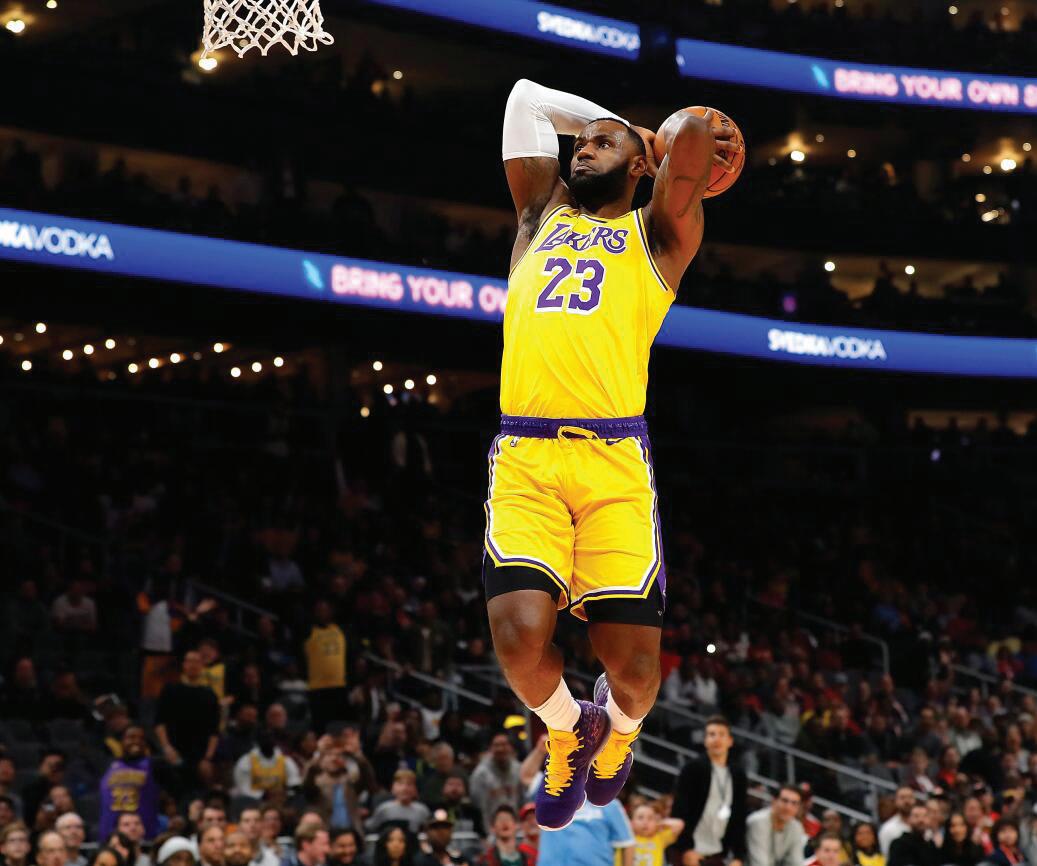
statement. “Well, I don’t know how to feel at the moment,” he admitted. “But once they retire, I think it’ll definitely hit.” His fondest memories revolved around the epic rivalry between Messi and Ronaldo and between LeBron James and Stephen Curry. “Every time they played each other was like a movie,” he recalled.

When asked about the likelihood of future stars reaching their heights, he said, “A solid no. LeBron for me is the GOAT and Curry’s shooting is out of this world, no one will reach him in terms of shooting. ... Messi and Ronaldo are so special, the things they do and have done will never be repeated.”


Farhad Sultani found himself grappling with the imminent retirement of LeBron James and Stephen Curry. “Wow, I never thought about it like that,” he said. “Knowing that they will not play anymore soon is just absolutely insane.” His favorite memory of LeBron James was his heroic performance during the 2018 season. “The way he carried that Cavs team is crazy.”
As for the possibility of anyone reaching the level of these greats, he said, “Curry is the greatest shooter there is, but there were some that got close to him. … But for LeBron, I don’t think so ... someone like him would be really hard to find, he has so many qualities that he is great at, and he has the most points which will probably never be broken.”
By: Sahil Ahmadi, Staff Reporter
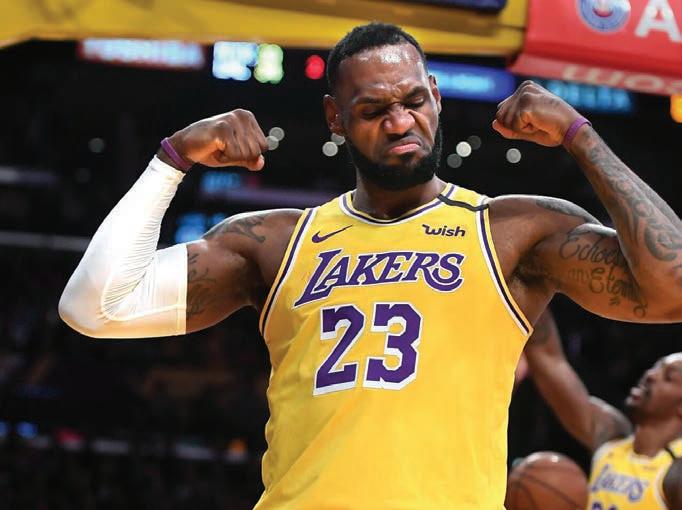
When training for injury prevention, student athletes often don’t know what is the best use of their time, “proprioceptive so I can use shoulders for example, in your normal, everyday life, you own positions, and then there are positions you don’t own… Most shoulder injuries are when your arms are out to your out to your sides” Torey Walter, a Physical Trainer on Rocklin campus says when asked about the best exercises for athletes.
When training for injury prevention, student athletes often don’t know what is the best use of their time, “proprioceptive so I can use shoulders for example, in your normal, everyday life, you own positions, and then there are positions you don’t own… Most shoulder injuries are when your arms are out to your out to your sides” Torey Walter, a Physical Trainer on Rocklin campus says when asked about the best exercises for athletes.
Walter adds that at the next level of play, “athletic trainers in the professional setting can focus more on that like pregame postgame recovery days and just do all kinds of rehabilitation with their injuries to help their athletes heal and recover and return to play faster.”
Surviving Sports
Surviving Sports
How does Lebron James win a championship at 35 and manage to be the oldest NBA player in the current league?
How does Lebron James win a championship at 35 and manage to be the oldest NBA player in the current league?
effect.” He responds with, “I think that’s just outlandish because you guys are so young, and you only have four years.”
effect.” He responds with, “I think that’s just outlandish because you guys are so young, and you only have four years.”
He’s not the only one, “I think multiple sport athletes are also the best way to go,” Walter says when asked about one mistake that young athletes should avoid. Eckman explains it with this, “You know the 1% better you might get by doing six of offseason training for one sport is not going to improve you the same way that putting you in a new situation, different competitions, different coaching.”
Walter adds that at the next level of play, “athletic trainers in the professional setting can focus more on that like pregame postgame recovery days and just do all kinds of rehabilitation with their injuries to help their athletes heal and recover and return to play faster.”
Matthew Eckman, the head track and field coach at Rocklin, as well as a former division 1 athlete, echoes the importance of the weight room, “The number one reason we weight train in the offseason for whatever sport whether it’s football, track and field is firstly to avoid injuries.” But weights aren’t the only way to compete, multi-sport athletes are on the rise. Eckman says, “You know, one of the things about the best athletes I see is that usually track and field is not their only sport. Usually they’re multi-sport athletes.”
Matthew Eckman, the head track and field coach at Rocklin, as well as a former division 1 athlete, echoes the importance of the weight room, “The number one reason we weight train in the offseason for whatever sport whether it’s football, track and field is firstly to avoid injuries.” But weights aren’t the only way to compete, multi-sport athletes are on the rise. Eckman says, “You know, one of the things about the best athletes I see is that usually track and field is not their only sport. Usually they’re multi-sport athletes.”
Eckman being a prominent coach and athlete in the area is at the forefront of conversations around athletics, “You know, it’s really interesting, because I’ve heard a lot of arguments lately, that by your sophomore or junior years, supposed to pick your one sport you like, and then stick with that or something to that
He’s not the only one, “I think multiple sport athletes are also the best way to go,” Walter says when asked about one mistake that young athletes should avoid. Eckman explains it with this, “You know the 1% better you might get by doing six of offseason training for one sport is not going to improve you the same way that putting you in a new situation, different competitions, different coaching.”
Besides multiple sport athletes, recovery and trainers play a large role in an athletes success. When asked about how she stays up to date on the latest developments, Walter has this to say, “A lot of that has to do with networking as well. So you’ll see in the medical field that there’s a lot of different things that work, but not every medical professional uses the same technique” She has learned from being in the industry how to filter information, “in our world of athletics, because there’s things that are like flashy and new. And when you look at the research, the research is done by that product. So obviously if they’re trying to sell the product, it’s going to be a positive outcome.”
Eckman being a prominent coach and athlete in the area is at the forefront of conversations around athletics, “You know, it’s really interesting, because I’ve heard a lot of arguments lately, that by your sophomore or junior years, supposed to pick your one sport you like, and then stick with that or something to that
Besides multiple sport athletes, recovery and trainers play a large role in an athletes success. When asked about how she stays up to date on the latest developments, Walter has this to say, “A lot of that has to do with networking as well. So you’ll see in the medical field that there’s a lot of different things that work, not every medical professional uses the same technique” She has learned from being in the industry how to filter information, “in our world of athletics, because there’s things that are like flashy and new. And when you look at the research, the research is done by that product. So obviously if they’re trying to sell the product, it’s going to be a positive outcome.”
The NBATA (National Basketball Athletic Trainers Association) released an article from some of the Lakers best and brightest trainers, “Peterson explained that he and his two assistants, Josh Wright and Adi Vase, have the players hold movements like a defensive stance for long periods of time to get the body
The NBATA (National Basketball Athletic Trainers Association) released an article from some of the Lakers best and brightest trainers, “Peterson explained that he and his two assistants, Josh Wright and Adi Vase, have the players hold movements like a defensive stance for long periods of time to get the body
used to it. They’ll do it under load, or weight, so that when their players are back on the court, it’s an easy adjustment.”
used to it. They’ll do it under load, or weight, so that when their players are back on the court, it’s an easy adjustment.”
We can see all of these things in effect right now with the Lakers 4 times championship winner. Lebron James has had some of the most expensive physical therapists staff, as well as being a multisport (high school football star) athlete. “Only two players have averaged 20 points in a season where they were 39 or older. James turns 39 on Dec. 30,” according to the NBA official website.
We can see all of these things in effect right now with the Lakers 4 times championship winner. Lebron James has had some of the most expensive physical therapists staff, as well as being a multisport (high school football star) athlete. “Only two players have averaged 20 points in a season where they were 39 or older. James turns 39 on Dec. 30,” according to the NBA official website.
Story By: Trey Joyce, Staff Reporter
Story By: Trey Joyce, Staff Reporter
Design by: Tristan Gurkin, Staff Reporter
Design by: Tristan Gurkin, Staff Reporter

41THE FLASH
41
Los Angeles Times
Los Angeles Times
MAKING THE TEAM MAKING THE TEAM
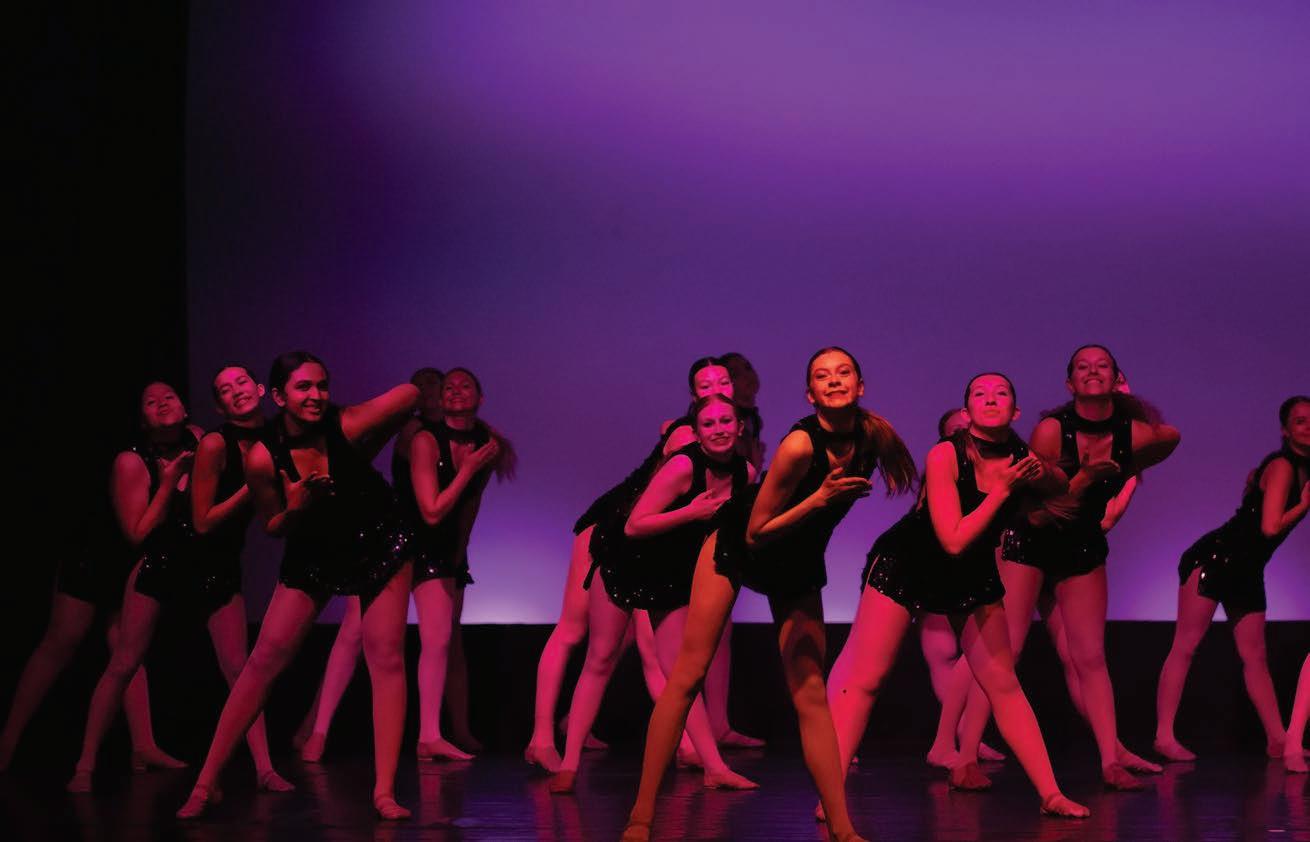
Learn more about the new members of the Rocklin High Shool Dance Team.
EEvery year they take their spot on the sidelines. They always wear blue dresses, gloves, and red lipstick, and they are an important part of making football games an enjoyable experience. But every year, as seniors graduate, we lose some of the familiar faces that we have watched during rallys, football games and more, opening up positions on the Rocklin High School Dance Team. It is typical for eighth graders to fill these open spots, but there are also students who have already attended RHS for a year or more who take an interest in dance. Apart from the incoming freshman who made the dance team, Sami Benkosky, an incoming sophomore, and Emma Weir, an incoming junior, will be joining the team for the first time next year.
Benkosky has always been passionate about dance. She said, “I am inspired to dance by the ability to express my creativity in a way that I truly love.” A few years back, when Benkosky found out about the success of the RHS dance team, she became “determined to make it.” She auditioned her freshman year but did not
earn a spot on the team. This did not discourage her. “[It] lit a fire under me and helped me become even more motivated
“[it] lit a fire under me and helped me become even more motivated to make the team this year.
to make the team this year,” she said. For the next year, she committed herself to improvment. “I took private lessons at my studio with one of my teachers to ensure that I was prepared for the auditions,” she said. Along with the private lessons she said that she “continued to better [herself] at home through strengthening exercises, which came in handy at auditions.” Because of all the hard work she put in, by the time auditions came around she felt very prepared. As for the actual auditions, Benkosky said, "The first few days were extremely nerve-wracking, but as the process continued, I found myself
growing bonds with some of the other girls, which I was so grateful for.” When she found out that she made the team she was “overjoyed that all of [her] hard work had paid off.” As she enters her sophomore year of high school, she is excited to build new relationships with her teammates and coaches. Through hard work and dedication she reached her goal. “I am just so proud of myself for improving so much throughout this last year, and how I made this dream come true,” she said.
Although her story is inspiring due to her accomplishments, she also struggled throughout the proccess. Sami had been diagnosed with tendonitis due to the hard work she was putting in to improve her dancing. Tendonitis is a condidtion that surfaces when tendons in a certain part of your body are overworked. “I had horrible pains and I had to go to physical therapy for several months,” Benkosky said. Her pain escalated to the point that she had to stop taking private lessons and focus on recovering. This did not stop her though. She said, “I continued to strengthen my body, and just before auditions began, I
was fully released from physical therapy.” She is thankful that she was able to start dancing again and said that she is “making sure that [her] body is properly cared for, both before and after dance.”
Emma Weir will also be joining the RHS Dance Team. She has only been dancing for three years, but her love for dance amounts to no less than the other girls’ on the team. She has found that dancing makes her feel happy. She said, “dance allows me to forget everything else going on in my life and only think about dance.” Though she hasn’t been dancing as long, one thing she thinks all the girls on the team can relate to is “how good it feels to dance.” Her dream to join the dance team started by watching the team perform at football games. As she watched them, she says that she admired how “they have such a strong bond with one another and
she struggles with fully allowing herself to let go while she dances. ”I think that I am afraid of being judged if I put too much energy or too much emotion into a dance,” she said. Another challenge for her that specifically arose during auditions was comparison. “I seemed to compare myself to the other girls auditioning, which caused me to second guess myself,” she said. To combat these struggles, Weir reminds herself of one thing — “the only competition I really have is with myself.” This reminder helped her become a better dancer and was a key factor in her making
By: Olivia Cruz, Staff Reporrter
“They have such a strong bond with one another and have so much pride in our school. This made me want to try and make the team so I can be a positive influence on someone else like how they were to me.”
have so much pride in our school. This made me want to try and make the team so I can be a positive influence on someone else like how they were to me.” Before the auditions started, she took extra steps to ensure she was prepared. “I made sure to take any extra time I had during the day to work on technique, I worked hard in both dance class at school and my studio,” she said. She also “talked with a couple of the current dance team girls about what to expect for auditions and any advice that they had.” Just like everyone else, Weir was nervous but very excited for auditions. This was her first audition ever and it was not easy. “It honestly kept getting harder and harder but it made me push myself the hardest I've ever had to,” she said. On a positive note, all of the girls were super sweet and uplifting which she said “ultimately got [her] through the proccess.” As Weir walked into her final meeting, she was preparing herself for the worst. After she found out she made the team, she was stunned. “It can't even process in my brain that I made the dance team.” She is proud of herself for working hard. She said, “It was all worth it in the end because I will remember this moment forever.”
Weir also faced challenges in the audition and preparation process. She found that
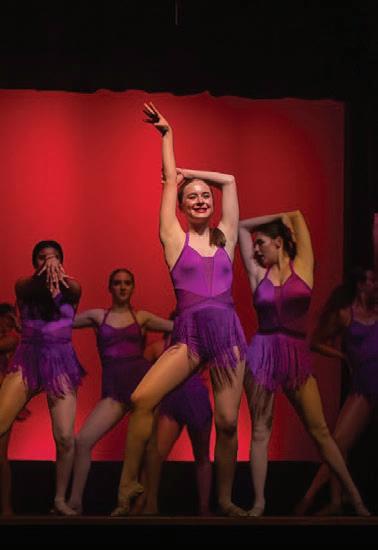
MAKING THE TEAM MAKING THE TEAM

43 THE FLASH

THE ROAD

They’ve done it, your Rocklin High School (RHS) varsity baseball team is league champion. This team is a marvel to see and is arguably one of the best teams RHS has had in the
RHS has had a remarkable season that will be remembered, going into the final series to win league. The team’s record was 18-7. RHS was also ranked 24th in California and dominated teams like Whitney, Oakridge, and Folsom. The team had over 170 runs scored, over 150
The team RHS had to face was Granite Bay (GB), which is ranked 12th in California and second in Sacramento. During their season, they accumulated 195 runs, over 250 hits, and seven home runs. They as well have had a dominant season with a record of 17-8 before they played RHS.
RHS and GB were in the hunt for the accomplishment of winning league and whoever took the series would win and become league champs. Senior Tucker Baird said, “It’s just one of those things that you just had to prepare mentally and just keep on fighting for because we lost the first game and we took a punch but we can throw a punch right back.”
The team lost the first game against GB, and as said by one of the coaches, the team had to have an “iron chin.” The team, now behind in the series, had to battle back and take the hit and move forward.
“Baseball is an up and down

sport, but I don’t think I’ve really lost confidence in us. I always knew that we’ve had a lot of comeback wins this season, so being down is nothing new to us, we are always confident in ourselves and trust in our abilities,” junior Dylan Nusz said.
With RHS being down the team had to
the game putting up eight runs beating GB 8-6. Some key players included Cash Brennan, who put up two RBIs; Daniel Panteloglow, who pitched five innings and walked away with the win; and Colby Pudge, who had three hits out of four at-bats, giving him a .750 average for that game.
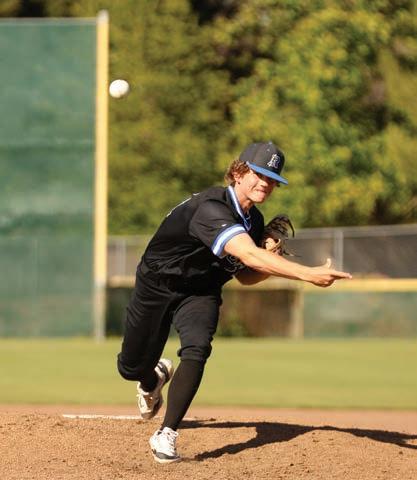
battle back. There were only two games left in the series to decide who would be league champs. The second game was close; RHS was tied throughout the game until the sixth inning, and GB took the lead by batting in two runs. RHS rallied back and responded by putting up five runs in the bottom of the sixth, winning and tying the series.
One last game to decide who is the league champion, the winner takes all. The final game of the series was played at GB’s home field, giving them the advantage, but that didn’t matter. RHS dominated
The team celebrated and were happy to become league champions and solidify their spot in history, but with that win now come playoffs. When asked how it felt to become league champs Nusz said, “At first it felt very good, but about 10 minutes after we all kinda realized that this was just one part of what we were really going for.”

What are they going for? They’re going for it all — they want a title bigger than league, they want to be the Division I section champs. Rocklin dominated their playoff run, beating teams like Downey, Lincoln of Stockton, and — in a very exciting series — Franklin. With this dominant run, they will now advance to sections.
RHS played St. Mary’s for the section title at Sac City College on May 23rd, 2024. When asking junior Daniel Panteloglow his thoughts on how the team should take the playoffs he said, “You know, we just got to go in there and try to take their starting guys out early. Get on them and show them that we can do the same thing as them”.
Sadly, RHS came short and lost the game against St. Mary’s. The team only batted in one running, losing 6-1. RHS season is not over though — they are still very much alive in the playoffs and will still play on. They will play at De la Salle for the Norcal championship and to advance to state. We all wish our boys luck and hope they continue to state and make this accomplishment.
By: Cole Broumas, Editor-in-Training
45 THE FLASH
CARA GONZALES
CARA GONZALES
CARA GONZALES

A SPECIAL THANKS TO...
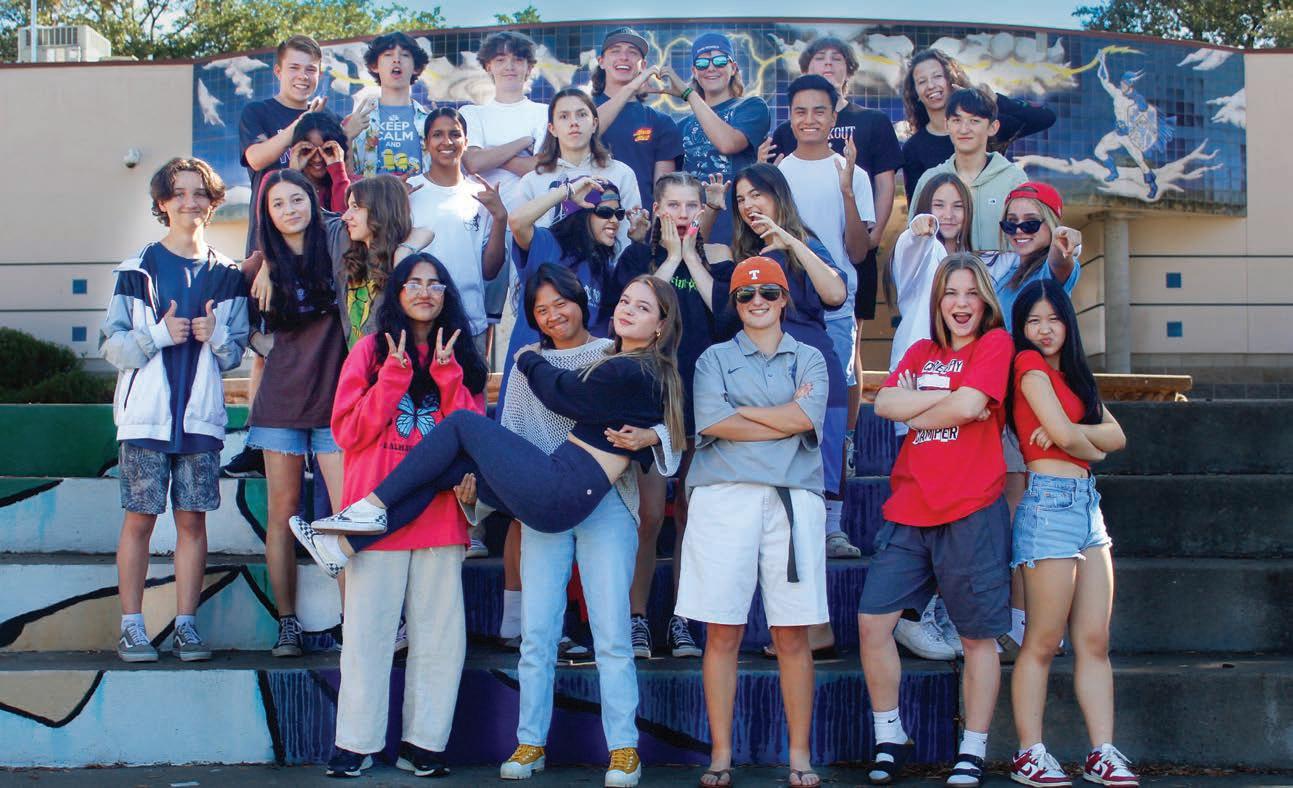
OUR JOURNALISM TEAM
ROCKLIN MEDIA: We write stories. We take pictures. We make cool things: Podcasts, Print Magazines, Online News. What about you? Do you like to write? Love to get to know people? Graphic design? Photography? Sign up next year for journalism, photojournalism, or publications class! Email Mr. Ruby for more info at: jrubinstein@rocklinusd.org

A
LOOK
LIVE FROM M5:
Check out Journalism’s student self-produced podcast that covers vast topics: Entertainment, Breaking News, Opinion, Features and more!
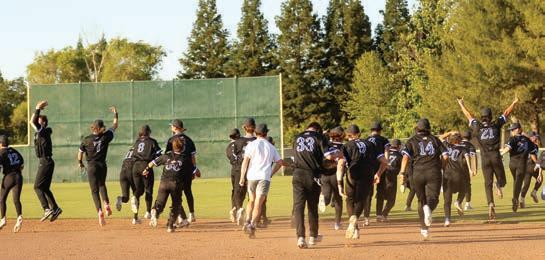
BEYOND THE SURFACE:
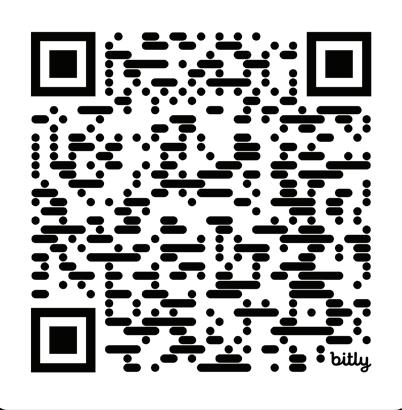
WE WILL HAND DELIVER A MAGAZINE TO YOU!
Use this QR code and fill out our Google form so we can deliver every issue of the 202425 Flash Magazine to you!
Check out “The Road to Glory” by Cole Broumas on page 44! RHS baseball celebrates a historic moment but remains focused on the ultimate prize.
VOLUME 31


















 Stories by: Saraswathi Murugan, Editor-in-Training
Stories by: Saraswathi Murugan, Editor-in-Training
 - Kaitlin Dunn, Senior.
- Kaitlin Dunn, Senior.















































 By: Saraswathi Murugan, Editor-in-Training
By: Saraswathi Murugan, Editor-in-Training




 EITAN RUBINSTEIN
Students watching a film in History Through Film
EITAN RUBINSTEIN
Students watching a film in History Through Film





















 2012 Signs with the Minnesota Vikings
2012 Signs with the Minnesota Vikings


















